single_layer_lift-off
LTE信令流程详解
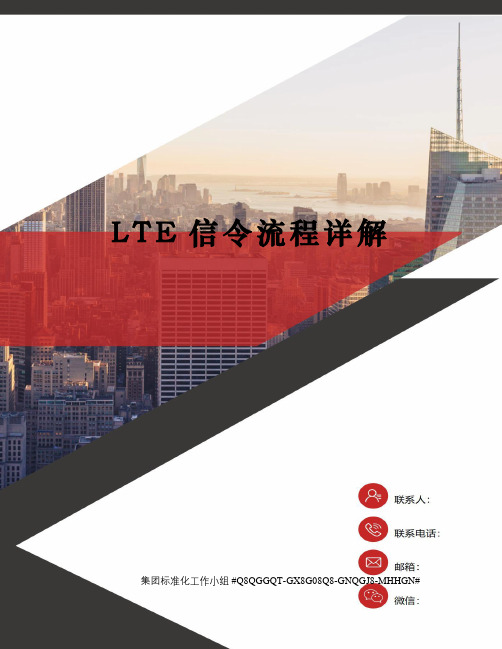
L T E信令流程详解集团标准化工作小组 #Q8QGGQT-GX8G08Q8-GNQGJ8-MHHGN#LTE信令流程目录概述本文通过对重要概念的阐述,为信令流程的解析做铺垫,随后讲解LTE中重要信令流程,让大家熟悉各个物理过程是如何实现的,其次通过异常信令的解读让大家增强对异常信令流程的判断,再次对系统消息的解析,让大家了解系统消息的特点和携带的内容。
最后通过实测信令内容讲解,说明消息的重要信元字段。
第一章协议层与概念1.1控制面与用户面在无线通信系统中,负责传送和处理用户数据流工作的协议称为用户面;负责传送和处理系统协调信令的协议称为控制面。
用户面如同负责搬运的码头工人,控制面就相当于指挥员,当两个层面不分离时,自己既负责搬运又负责指挥,这种情况不利于大货物处理,因此分工独立后,办事效率可成倍提升,在LTE网络中,用户面和控制面已明确分离开。
1.2接口与协议接口是指不同网元之间的信息交互时的节点,每个接口含有不同的协议,同一接口的网元之间使用相互明白的语言进行信息交互,称为接口协议,接口协议的架构称为协议栈。
在LTE中有空中接口和地面接口,相应也有对应的协议和协议栈。
信令流数据流图1 子层、协议栈与流图2 子层运行方式LTE系统的数据处理过程被分解成不同的协议层。
简单分为三层结构:物理层、数据链路层L2和网络层。
图1阐述了LTE系统传输的总体协议架构以及用户面和控制面数据信息的路径和流向。
用户数据流和信令流以IP包的形式进行传送,在空中接口传送之前,IP包将通过多个协议层实体进行处理,到达eNodeB后,经过协议层逆向处理,再通过S1/X2接口分别流向不同的EPS实体,路径中各协议子层特点和功能如下:1.2.1NAS协议(非接入层协议)处理UE和MME之间信息的传输,传输的内容可以是用户信息或控制信息(如业务的建立、释放或者移动性管理信息)。
它与接入信息无关,只是通过接入层的信令交互,在UE和MME之间建立起了信令通路,从而便能进行非接入层信令流程了。
水利水电工程英文专业词汇
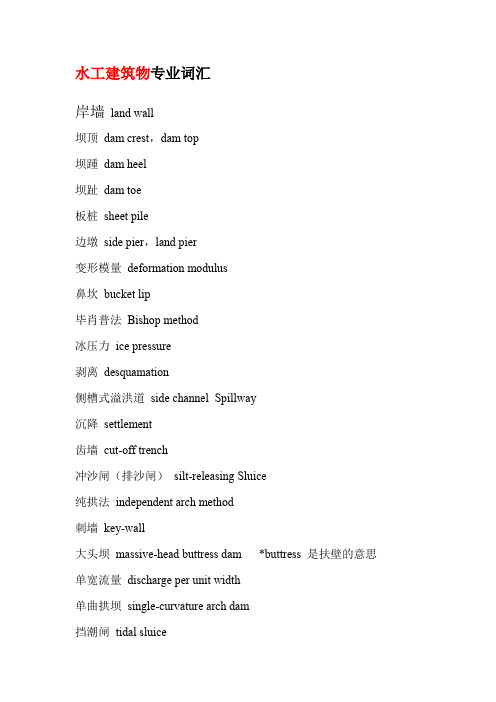
水工建筑物专业词汇岸墙land wall坝顶dam crest,dam top坝踵dam heel坝趾dam toe板桩sheet pile边墩side pier,land pier变形模量deformation modulus鼻坎bucket lip毕肖普法Bishop method冰压力ice pressure剥离desquamation侧槽式溢洪道side channel Spillway沉降settlement齿墙cut-off trench冲沙闸(排沙闸)silt-releasing Sluice纯拱法independent arch method刺墙key-wall大头坝massive-head buttress dam*buttress 是扶壁的意思单宽流量discharge per unit width单曲拱坝single-curvature arch dam挡潮闸tidal sluice导流隧洞river diversion tunnel倒悬度Overhang degree底流消能energy dissipation by underflow地震作用earthquake action垫座cushion abutment动水压力hydrodynamic pressure断层fault堆石坝rock-fill dam多拱梁法multi-arch beam method阀门valve gate防浪墙wave wall防渗铺盖impervious blanket非常溢洪道emergency spillway分洪闸flood diversion sluice副坝auxiliary dam刚体极限平衡法limit equilibrium method for rigid block 拱坝arch dam拱冠梁crown cantilever拱冠粱法crown cantilever method工作桥service bridge固结灌浆consolidation grouting灌溉隧洞irrigation tunnel灌浆帷幕grout curtain管涌piping海漫apron extension横缝transverse joint虹吸式溢洪道siphon spillway蝴蝶阀butterfly valve护坡slope protection护坦apron弧形闸门radial gate滑雪道式溢洪道ski-jump spillway化学管涌chemical piping混凝土防渗墙concrete cut-off wall混凝土面板堆石坝concrete faced rock-fill dam 基本断面primary section简化毕肖普法simplified Bishop method浆砌石拱坝stone masonry arch dam浆砌石重力坝stone masonry gravity dam交通桥traffic bridge接触冲刷contact scouring接触灌浆contact grouting接缝灌浆joint grouting截水槽cut-off trench节制闸check sluice进水口water inlet进水闸inlet sluice井式溢洪道shaft spillway静水压力hydrostatic pressure均质坝homogeneous earth dam抗滑稳定分析analysis of stability against sliding 抗滑稳定性stability against sliding空腹重力坝hollow gravity dam空化cavitation空蚀cavitation erosion空注阀hollow jet valve宽缝重力坝slotted gravity dam宽尾墩flaring pier廊道gallery浪压力wave force理论计算theoretical computation拦河闸river sluice沥青混凝土asphalt concrete连拱坝multiple-arch dam流土soil flow流网法flow net method锚杆anchor rod面板face slab面流消能energy dissipation by surface flow模型试验model experiment泥沙压力silt pressure碾压混凝土坝Roller Compacted Concrete Dam 牛腿Corbel排沙隧洞silt-releasing tunnel排水drainage排水闸outlet sluice喷混凝土sprayed concrete平板坝flat slab buttress dam平面闸门plane gate破碎带crushed zone铺盖blanket砌石护坡stone pitching人工材料面板坝artificial material faced dam 人工材料心墙坝artificial material-core dam溶洞solution cavern软基重力坝gravity dam on soft foundation软弱夹层soft intercalated layer实用断面practical section试载法trial-load method双曲拱坝double-curvature arch dam水工建筑物hydraulic structure水工隧洞hydraulic tunnel,waterway tunnel 水力发电隧洞hydropower tunnel水利枢纽hydro-complex水力学方法hydraulics method水平施工缝horizontal joint水闸sluice弹性模量elastic modulus挑流消能energy dissipation by trajectory jet土工膜geomembrane土石坝earth-rock dam土质斜墙坝earth dam with inclined soil wall 土质斜心墙坝earth dam with inclined soil core 土质心墙坝earth dam with soil core帷幕灌浆curtain grouting温度荷载temperature load温度控制temperature control温度应力temperature stress温度作用temperature action无压隧洞free level tunnel消力池stilling pool消力戽roller bucket消能工energy dissipater泄洪隧洞spillway tunnel泄水建筑物discharge structure泄水孔outlet hole新奥法NATM(New Austrian Tunneling Method)胸墙breast wall扬压力uplift溢洪道spillway水垫塘plunge pool溢流坝overflow dam、翼墙wing wall应力分析stress analysis优化设计optimization design有限单元法finite element method有压隧洞pressure tunnel闸墩pier闸门gate闸门槽gate slot正槽式溢洪道normal channel spillway整体式重力坝monolithic gravity dam趾板toe slab支墩坝buttress dam重力坝gravity dam重力墩gravity abutment 周边缝peripheral joint 驻波standing wave锥形阀cone valve自由跌流free drop自重dead weight纵缝longitudinal joint键槽key strench伸缩缝contraction joint 施工缝construction joint 反弧段flip bucket拦污栅trash rack渐变段transition泄槽chute发电进水口power intake 通气管air vent检修门bulkhead gate事故门emergency gate 工作门service gate堰weir通气管air vent胸墙breast wall梁beam柱column回填混凝土backfill concrete 接地earth一期混凝土primary concrete 二期混凝土secondary concrete 叠梁门stoplog门机gantry crane止水waterstop钢筋reinforcement模板formwork围堰cofferdam马道bench;berm蜗壳volute水轮机turbine电站power house车间workshop发电机generator变电站transformer station副厂房auxiliary power house安装间erection bay尾水闸门tail lock尾水渠tailrace引水渠approach channel前池fore bay导墙lead wall隔墙partition wall接触灌浆contact grouting回填混凝土backfill concrete帷幕灌浆curtain grouting挡墙retaining wall港口harbour港口建筑物port structure船闸navigation lock船闸充水lock filling船闸充水和泄水系统locking filling and emptying system 船闸前池upper pool船闸上下游水位差lock lift船闸闸首lock head升船机ship elevator;ship lift鱼道fish canal旁通管by-pass 齿槽cut-off wall。
Autodesk Nastran 2023 参考手册说明书
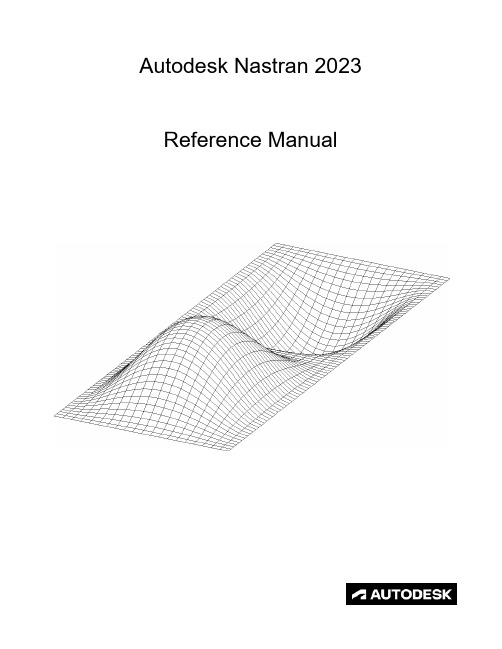
FILESPEC ............................................................................................................................................................ 13
DISPFILE ............................................................................................................................................................. 11
File Management Directives – Output File Specifications: .............................................................................. 5
BULKDATAFILE .................................................................................................................................................... 7
汽车专业英语词汇(4)_交通运输英语词汇

两片法 two-plate method单片法 single-plate method含水量 moistrue content单轮控制 individual wheel control多轮控制 multi wheel control轴控制 axle control边控制 side control对角控制 diagonal control组合多轴控制 combined multi-axle control可变选择 variable selection最低控制速度 minimum control speed传感器信号选择 sensor signal低选择 select -low高选择 select-high预定选择 predetermined selectin车轮选择 selection by wheel平均选择 average selecton分辨率 resolution rate控制周期 control cycle控制频率 control frequency控制力 control force作用力 control froce制动器效能因素 application force制动器材的滞后 brake hysteresis制动器输出力矩 brake output torque制动器额定力矩 brake rating torque制动蹄效能因素 brake shoe efficiency factro制动蹄作用压力 application pressure of brake shoe assebmly 制动蹄释放压力 release pressure of brake shoe最大制动蹄中心升程 maximum shoe centre lift制动鼓直径 drum diameter制动鼓宽度 drum width制动鼓厚度 drum thickness制动盘厚度 disc thickness(鼓或盘)的摩擦面积 swept area制动衬片吸收功率 power absorption of lining制动衬片包角 lining arc制动衬片单位面积制动力 lining drag衬片摩擦系数 lining mu衬片摩擦面积/每轴 lining area/axle衬片摩擦面积/每个制动器 lining area/brake踏板行程 pedal travel踏板自由行程 free pedal travel踏板最大行程 maximum pedal travel踏板力 pedal effort有效踏板长度 effective pedal length踏板速比 pedal velocity ratio踏板回位弹簧力 pedal return spring load踏板回位弹簧刚度 pedal return spring rate制动初速度 initial speed of braking制动减速度 braking deceleration瞬时制动减速度 instantaneous braking deceleration 平均制动减速度 mean braking deceleration最大制动减速度 maximum braking deceleration石油基制动液 petroleum base brake fluid非石油基制动液 non-petroleum base brake fluid最低湿沸点 minimum wet boiling point防冻液 anti-freeze liquid冷却液 cooling liquid供能装置 energy supplying device真空泵 vacuum pump喷射器 ejector真空罐(筒) vacuum tank空压机 air compressor气缸盖 cylinder head气缸体 cylinder block活塞 piston火塞环 piston ring连杆 connecting rod活塞销 piston pin曲轴 crank shaft进气阀 intake valve排气阀 exhaust valve储气罐(筒) air storage reservoir调压阀 pressure regulating valve单向阀 single check valve止回阀、单向阀 check valve滤清器 filter进气滤清器 air intake filter排气滤清器 air exhaust filter管路滤清器 line filter滤网(芯) strainer油水分离器 oil and water seperator防冻器 aiti-freezer空气干燥器 air dryer排放阀 drain valve压力保护阀 pressrue protection valve控制装置 control device行车制动踏板装置 service braking pedal device 制动踏板 braking pedal踏板护套 pedal pad踏板支架 pedal brackeet衬套 bushing套管 collar销轴 axis pin回位弹簧 retruen spring驻车制动操纵装置 parking brake control device操纵杆 control lever操纵杆支架 control lever bracket操纵杆导套 control lever guide collar齿杆(棘轮) rod rack(ratchet)棘抓 ratchet pawl操纵揽绳 control cable平衡臂 equalizer拉杆(拉绳) pull rod(pull wire)拉杆导套 pull rod guide collar制动杆 brake lever手制动杆 hand lever气制动阀 aire brake valve单腔气制动阀 single-chamber air brake valve推杆 plunger气阀 air valve平衡弹簧 equalizing spring膜片 diaphragm双腔气制动阀 dual-chamber air brake valve串列式双腔气制动阀 series dual -chamber air brake valve 并列式双腔气制动阀 parallel dual-chamber air brake valve 三腔气制动阀 triple-chamber air brake valve三通路控制阀 three way control valve双向止回阀(双通单向阀) dual way check valve继动阀 relay valve快放阀 quick release valve继动快放阀 relay and quick release valve挂车制动阀 trailer braking valve挂车制动应急继动阀 trailer braking relay emergency valve挂车制动保护阀 trailer braking protecton valve挂车制动放松阀 trailer braking relax valve手控制动阀 hand braking valve传能装置 transmission device制动主缸 brake master cylinder有补偿孔式制动主缸 compensating brake master cylinder无补偿孔式制动主缸 portless brake master cylinder串列双腔式制动主缸series dual chamber brake master cylinder盘式制动器制动缸 disc brake cylinder双腔制动主缸 tandem master cylinder主腔 primary chamber应急腔 secondary chamber膜片 diaphragm主缸缸体 master cylinder body皮碗防护垫 cup protector主皮碗 primary cup皮圈(副皮碗) ring cup副皮碗 secontary cup弹簧座 spring seat活塞挡圈 piston stopper卡环 snap ring主缸推杆 master cylinder push rod连接叉 clevis防尘罩(套) boot残留阀 residual valve储液室 fluid reservoir主缸储液室 master cylinder reservoir储液室盖 fluid reservoir cap进油阀 inlet valve第一活塞 first piston第二活塞 secondary piston轮缸 wheel cylinder伺服机构 servo mechanism助力器 booster真空助力器 vacuum booster反馈杠杆 reaction lever反馈盘 reaction plate伺服阀 servo valve反馈柱塞 reaction plunger伺服活塞 servo piston助力活塞 boosting piston伺服膜片 servo diaphragm助力膜片 boosting diaphragm真空增压器 vacuum intensifier控制阀体 control valve body阀门弹簧 valve spring控制膜片回位弹簧 control diaphragm return spring 控制膜片 control diaphragm控制活塞 control piston控制活塞皮碗 control piston cup辅助缸缸体 auxiliary cylinder body液压活塞 hydraulic piston液压阀 hydraulic valve端盖 end plate气压助力器 air booster气压-液压增压器 air over hydraulic intensifier 气顶油助力器 air over hydraulic booster管件 pipe unit管路 pipe-line传能管路 energy transmission lines供能管路 energy transmission lines供给管路 feed pipe控制管路 supply line促动管路 control line操纵管路 pilot line共用管路 common line应急管路 emergency line制动管路 braking line应急制动管路 secondary line刚性件 rigid pipe半刚性管 semi-rigid pipe软管 flexible pipe电缆或导线 cable or wire制动软管总成 brake hose assemblies制动软管 braking hose液压软管 hydraulic hose软管保护管 hose protector气制动软管 airbrake hose跨接软管 jumper hose桥式管 bridge pipe热塑管路 thermo-plastic tubing软管卡子 hose clip橡胶内衬 elastometric lining层 layer(plie)加强帘线编织层 textile reinforcing cord层迭迭外层 outer cover管接头 pipe fittings制动软管管接头 btrake hose end fitting挂车制动接头 coupling head压力接头 compression fittings接头体 fittings body接头轴心 coupling axis密封圈 sealing ring压力环 pressure ring管座 pipe seat管螺母 pipe nut推力接头 thrust fitting内锥座接头体 fitting body with innerconical seat快速接头 quick fitting跨接软管连接器 jumper lose connection气制动管连接器 pneumatic braking connection制动气室 brake chamber膜片式制动气室 diaphragm brake chamber活塞式制动气室 piston brake chamber储能弹簧制动气室 energy storage spring brake chamber储能弹簧放松机构 energy storage spring release mechanism 随动件 follower推杆 pusher锁止式制动气室 lock brake chamber锁止腔 lock chamber琐止弹簧 lock spring楔环 wedge ring制动蹄促动器 brake shoe actuator储能弹簧 energy storage spring制动器 brake摩擦式制动器 frictin braek鼓式制动器 drum brake盘式制动器 disc brake多片盘式制动器 multiple disc brake挂车制动器 trailer brake超速制动器 overrun brake液压制动器 hydraulic brake内涨型鼓式制动器 internal expanding drum brake双领蹄式制动器 two leading shoe brake双从蹄式制动器 two trailing shoe brake双向双领蹄式制动器 dual two leading shoe brake双向双从蹄式制动器 dual two trailing shoe brake领从蹄式制动器 leading trailing shoe brake单向伺服式制动器 uni-servo brake双向伺服式制动器 duo-servo brake外收缩型鼓式制动器 external contracting drum brake 帘式制动器 band brake钳盘式制动器 caliper disc brake定钳盘式制动器 disc brake with fixed caliper浮钳盘式制动器 disc brake with floating caliper浮盘式制动器 floating disc brake全盘式制动器 complete disc brake凸轮张开式制动器 cam brake楔式制动器 wedge brake轮缸式制动器 wheel cylinder brake刚性连接式制动器 positive engagement brake驻车制动器 parking brake盘式中央制动器 transmission disc brake带式中央制动器 transmission band brake手制动器 hand brake冷制动器 cold brake制动鼓 brake drum双金属式制动鼓 bimetallic shoe brake drum 制动鼓衬里 brake drum liner制动鼓缘圈 drum rim制动鼓散热肋 brake drum cooling rib制动底板 brake bottom plate制动蹄 brake shoe制动蹄总成 brake shoe assembly领蹄(紧蹄) primary shoe(leadijg shoe)从蹄(松蹄) secondary shoe(trailing shoe) 销式蹄 pivoted shoe滑动式蹄 sliding shoe铰接式蹄 articulated shoe刚性蹄 rigid shoe半刚性蹄 semi-flexible shoe蹄跟部 heel蹄前端部 toe间隙调整装置 lash adjusting device调整臂 adjusting arm调整臂总成 adjusting arm assembly制动凸轮轴 brake camshaft制动蹄限位弹簧 brake shoe hold down spring 制动蹄回位弹簧 brake shoe return spring制动蹄支承座 brake shoe abutment支承销 anchor pin支承块 anchor plate制动蹄导板 brake shoe link蹄片张开装置 shoe expander mechanism蹄片(自动)调整装置 brake shoe(automatic )adjuster 制动蹄张开杠杆 expander lever制动蹄张开凸轮 expander cam驻车制动杠杆 parking brake lever驻车制动推杆 parking brake push-rod制动轮缸 brake cylinder制动带 brake band制动盘 brake disc制动钳 brake caliper制动钳板臂 brake caliper plate yoke制动钳安装架 brake caliper mounting bracket制动块总成 brake pad assembly盘式制动衬块 disc brake pad制动衬块背板 brake pad back plate制动衬片 brake lining缓冲器 retarder发动机缓冲装置 retarder by combustion engine电机缓冲装置 retarder by electric traction motor液力缓冲器 hydro-dynamic retarder气动缓冲器 aerodynamic retarder电磁缓冲器 electromagnetic retarder空气动力缓速装置 aerodynamic retarder排气缓速器 exhaust retarder排气节流器 exhaust shutter valve进气消声器 intake silencer控制缸 control cylinder电磁缓速器 electromagnetic retarder盘形转子 discal rotor定子电磁铁组 stationary electromagner环形定子 stationary torus电磁铁心 electromagnet core激磁线圈 field winding(field coil)液力缓速器 hydrodynamic retarder双叶片转子 double runner rotor排液管 drain pipe作动拉杆 actuating link排气管 exhaust pipe断油拉索 cut-off link辅助装置 auxiliary device保护压力装置 protection pressure device制动力调节装置 device to apply correction to braking force 车轮防抱死装置 anti-lock device传感器 sensor控制器 controller调节器 modulatro限压阀 proessure limiting valve比例阀 proportioning valve异径活塞 different diameter piston阀体 valve body压力控制弹簧 pressure control spring阀弹簧 valve spring阀 valve惯性比例阀 inertia proportioning valve惯性球 inertia ball球阀座 ball valve seat感载比例阀 loading sensing pressure proportoining valve 感载限压阀 loading sensing pressure limiting valve惯性防抱死装置 inertia anti-lock device电子防抱死装置 eoectro anti-lock device报警装置 warning device真空报警开关 vacuum warning switch低压报警开关 low pressure warning switch液面报警开关 level warning switch作用机构 application mechanism磨损补偿装置 wear compensation device限位装置 inhibiting device弹簧制动器的辅助放松装置 auxiliary release device for spring-brake actuator防弯折装置 king protection device托板 carrier防铰接系统 anti-link system附加装置 additional device安全缸 safety cylinder抑制螺拴 check bolt抑制螺母 check nut空气溢流阀 air bleed valve安全阀 safety valve压差控制阀(优先阀) pressure-gradient control valve十字单向阀 spider singe check valve差压阀 defferential valve气压制动阀 air brake valve分立制动阀 dual air brake valve继动阀 relay valve快放阀 quick release valve安全继动阀 safety relay valve双进口单向阀 double way check valve调压阀 pressure governor保险阀 relief valve继动应急阀 relay emergency valve牵引车保护阀 tractor protection valve液压继动阀 dydraulic relay valve手制动阀 hand brake valve制动灯开关 braking light switch分离开关 shut-off switch气压表 air gauge试验 test缩颈试验 constriction test抖动试验 whip test膨胀试验 expansion test拉伸试验 tensile test吸水试验 water absorpton test冷弯实试验 cold bend test耐臭氧试验 ozone resistance test盐雾试验 salt spray test中性盐雾试验 neutral salt spray test 鉴定试验 qualification test成批验收试验 lot acceptance热压反复试验 heat pressure stroking 张紧变形试验 tension set test冷效应试验 cold effectiveness test热衰退试验 fade test预备试验 preliminary test强度试验 strength test静态驻坡试验 static hill-holding test 颜色耐久度试验 test for color fastness 冷弯试验 cold impact test热弯试验 hot impact test爆裂试验 burst test试验设备(台) test rig塞规 gauge plug防潮材料 moisture barrier material滴定管 burette添加剂 additve空气游离 free of air挠曲试验机 flexing machine吸油绳 wick加热罩 heating mantle烧瓶 flask沸腾石 boiling stone玻璃仪器 glassware冷凝器 condenser环形夹子 ring clamp硬石棉耐火垫 hard asbestos refractory 腐蚀试瓶 corrosion test jar螺旋盖 screw-top干燥器 desiccator烘箱外罩 oven enclosure金钢砂纸 silicon carbide paper松节油 white spirit钢丝棉 steel wool钳子 forceps软木塞 cork培养皿 petri dish离心试管 centrifuge tube橡胶防护套 elastometric boot臭氧箱 ozone chamber冲程试验装置 stroking fixture抛光机 polished machine扩张芯轴 stretching mandrel千分尺 micrometer投影检测仪 shadowgraph玻璃容器 glass container镀锡钢盖 tinned steel lids不起毛布 lint-free cloth包装屑 packing debris湿度箱 humidity cabinet加热板 heating plate载荷锤头 loading ram拉力机 tensile machine压力机 compression machine夹具 fixture拉头block导轨 guide砂纸 emery paper材料剪切试验台 material shear test rig吸水石 absorbent paper增湿 humidification雾化 atomization拉伸强度 tensile strength屈服点 yield point破坏时伸长量 elongation at break化学试剂 reagent盐溶液 salt solution酒精-蒸馏水混合液 ethanol/distilled water mixture 玻璃电极 glass electrode杂质 impurities悬浮固体物 suspended solids沉淀液 precipitaton number不透明液 opaque transparent liquid中和值 neutralization number电位滴定法 potentiometric titration平衡回流沸点 equilibrium reflux boiling point(erbp 湿式平衡沸点 wet equilibrium reflux boiling point ph值 ph value污斑 staining变色 discoloration胶状物 jelly无结晶型沉淀物 no crystalline-type deposit流动性 fluidity遮盖力图 hiding power chart黑白分辨线 black contrast lines分层 stratification沉淀 sedimentation硬度 hardness油泥 sludging磨粒 abrasive grains化学转化 chemical reversion气候老化 weather ageing变质 deterioration报废 rejection刀痕 cut麻点 pit针孔 pin-hole凸起 protuberance烘箱老化 oven ageing冷放时间 soaking time使用温差 service temperature制动器失效 misfunctioning of brake试验跑道 test track路面 surface弯道 bend普通水泥混凝土 portland cement concrete 转弯 corner坡度 gradient路拱 camber点刹 snub过大跑偏 undue deviation满载停车 laden stops防水性 protection against ingress of water 防尘性 protection against dust热衰退 heat fade水衰退 water fade恢复 recovery过恢复 over recovery增强(突升) build up制动气阻 braking vapor lock龟裂 crack热龟裂 heat crack制动拖滞 braking drag冷制动弊病 cold braking sickness制动颤振 brake chatter制动噪声 brake noise车轮抱死 wheel lock制动跑偏 braking deviation制动甩尾 braking swerve制动折叠 braking jack-knifing制动跳动 braking hop制动失效 braking failure制动滑移 braking skid制动点头 braking nose dive电气设备和操纵件 electric equipment and controls 通用术语 general tems要求电压 required voltage标称电压 nominal voltage外部电源 external power supply外部稳压电源 external stabilized power针式仪器 pointer instrument测量电阻 measuring resistor电阻值 resistance value平均电力输入 mean electrical power input串联电阻 series resistors预热 warming up电晕效应 corona effect压痕 indentation过热试验 thermal overload test热收缩 shrinkage by heat抗火焰传播性 resistance to flame propagation本生灯 bunsen-burner剥开绝缘 stripping of insulatin热老化试验 heat ageing test快速寿命试验 accelerated life test卷绕试验 winding test耐磨损性 abrasion test擦刮磨损试验 scrape abrasion test线层包覆层 strand coating击穿 dielectric puncture绝缘击穿 dielectric tracking搭铁 ground (earth0正极搭铁 plus earth负极搭铁 minus earth内搭铁 internal earth外搭铁 external earth火线 hot wire电干扰 electrical distrubance瞬变 transient瞬变时间 transient duration上升时间 rise time下降时间 fall time脉冲周期 pulse cycle time失效程度的等级 failure mode severity classification 试验脉冲和试验方法 test pulse and method试验脉冲强度 test pulse severity耦合 coupling耦合网络 coupling network抗耦合网络 decoupling network耦合夹钳 coupling clamp电瞬变 electrical transients瞬变传递 transient transmission脉冲重复频率 pulse repetition rate脉冲宽度 pulse width模拟网络 artificial network电磁环境 elecromagnetic environment瞬变发射 transient emission电压瞬变 voltage transient并联电阻 shunt resistor波形探测仪器 waveform acquisition equpment电源切断 supply disconnecton瞬变免疫性 transient immunity脉冲发生器 pulse generator线束阻抗 impedance of wiring harness感应系数 inductance线绕电阻 wire-wound resistor内部电阻 internal resistance浪涌电流 inrush current附加波动电压 superimposed ripple voltage 频率宽度 band width扫描速度 writing speed输入灵敏度 input sensitivity衰减精度 attenuation accuracy接通转速 cut-in frequency零电流转速 zero-amp frequency使用转速 application frequency空载转速 cut-in speed负载转速 load speed外部激励 external excitation简化试验 short form test预热试验 warm test离散点法 discrete point method连续测量法 continuous mode method反电动势 back-electromotive force磁通量 magnetic flux磁场 magnetic field磁场电流 field current直流电压表 dc voltmeter电流检测器 current probe内装式传感器 built-in sensor示波器 oscilloscope负荷电容 load capacity插入式传感器 plug-in sensor负荷电阻 load resistor发电机 generator(dynamo)直流发电机 dc generator (dynamo)前端盖 dirve end baring bracket后端盖 commutator(slip ring )end bearing bracket 机壳 frame定子总成 stator assembly (field frame assembly) 磁场绕组 field coil(excitation winding)电枢总成 armature assembly电枢绕组 armature winding换向器 commutator电刷 brush电刷架 brush spring电刷弹簧 brush spring“a”接线柱 armature terminal (output terminal) “f”接线柱 field terminal“e”接线柱 earth terminal交流发电机 alternator (ac generator)无刷交流发电机 brushless alternator整体式交流发电机 integrate alternator转子总成 rotor assembly定子铁芯 stator core散热板 heat sink爪极 claw pole磁轭 yoke滑环 slip ring(collector ring)整流器 rectifier二极管 diode功率二极管 power diode“b”接线柱 battery terminal“n”接线柱 neutral terminal输出特性曲线 output characteristic curve最大输出电流 maximum current output磁场电流 fiel current直流发电机调节器 dc generator regulator电压调节器 voltage regulator电流限制器 current limiter继电器 relay截流继电器 cutout relay交流发电机调节器 alternator regulator磁场继电器 field relay充电指示继电器 chaerge indicator relay电磁振动式调节器electromagnetic regulator (vibrating type regulator)单级电磁振动式继电器 single stage voltage regulator双节电磁振动式调节器 double stage voltage regulator调节电阻 regulating resistor加速电阻 accelerating resistor铁芯 core衔铁 armature搭铁螺钉 eqrth screw磁分路片 magnetic by-pass plate晶体管调节器 transistor regulator集成电路调节器 ic regulator (solid state regulator)内装式调节器 built-in voltage regulator调节电压 regulating voltage限制电流 limiting current闭合电压 cut-in voltage逆电流 reverse current蓄电池 battery (accumulator)镍-镉蓄电池 nickel-cadmuum battery镍-铁蓄电池 nickel-iron battery酸性蓄电池 acid battery铅酸蓄电池 lead-acid battery密封蓄电池 no-service battery干蓄电池 dry -charged battery免维护蓄电池 maintenance free battery并联电池组 batttery in quantity蓄电池外壳 battery jar(accumulator jar)蓄电池壳体 battery case蓄电池单元 battery cell蓄电池盖 cell lid蓄电池加电水口塞 cell filler plug蓄电池联条 cell connector穿通式联条 over-partition connector蓄电池极板组 pass through partition connector 栅板 palte grid负极板 negative plate正极板 positive plate沉淀物储存槽 sediment chamber极板活性物质 plate active material电解液 electrolyte (battery solution )电界液液面高度 electrolyte level蓄电池吊架 cell hanger极性 polarity蓄电池接柱 battery post阳极接头 hot post边接头 side post正极接线柱 positive terminal负极接线柱 negative terminal绝缘层 insulating laminaiton氢氧化镍 nickel hydroxide起动机 starter(starting motor,cranking motor)电磁开关 solenoid switch吸引线圈 pull-in winding保持线圈 holding winding起动继电器 starter relay机械啮合式起动机 mechanically engageddrive starter预啮合式起动机 pre-engaged drive starter电枢移动式起动机 sliding armature starter齿轮移动式起动机 sliding gear starter同轴式起动机 coaxial drive starter惯性式起动机 inertial drive starter预热器 intake air heater电热塞 glow plug热电丝式指示器 glow indicator点火系统 ignition system传统点火系统 conventional igniton system半导体点火系统 semi-conductor ingnition sytem电子点火系统 electronic ignitin system电感点火系统 inductive ignitin system电容放电点火系统 capacitor discharge ignition system半导体辅助点火系统 semi-conductor assisted ignition system 触点式点火系统 contact-controlled ignition systme无触点式点火系统 breakless ignition system磁脉冲信号发生器 magnetic pulse generator传感线圈 pick-up coil光电信号发生器 photoelectric signal generator点火脉冲信号放大器 ignition pulse amplifieer无分电器点火系统 distributorless ignition sytem离心提前机构 centrifugal advance mechanism真空提前机构 vacuum advance mechanism触点间隙 point gap次级有效高压 secondary available voltage火花塞需要电压 required spark plug voltage点火电压储备 ignition voltage reserve次级输出电压 secondary output voltage次级电压上升时间 secondary voltage rise time平均输入电流 average current input峰值线圈电流 peak coil current断电电流 interruption current断电触点电流 contacet breaker current初级供电电流 primary supply voltage线圈初级感应电压 coil primary induced voltage最低工作转速 minimum operating speed储存能量 stored energy励磁时间间隔 energizing interval (dwell angle)最高连续发火转速 maximum continued sparking speed 最高断火转速 maximum misfire revolution发火率 sparking rate点火提前角 spark advance angle离心提前角 centrifugal advance angle分压器 voltage divider放大器 amplifier储存能量 stored energy火花塞 spark plug冷型火花塞 soft plug中型火花塞 normal plug热型火花塞 hard plug前置火花塞 leading spark plug后置火花塞 trail spark plug长螺纹(长型)火花塞 long-reach plug突出型火花塞 projectred nose type spark plug 锥座型火花塞 conical seat type spark plug矮型火花塞 compact type spark plug抑制型火花塞 seppresssed type spark plug电阻型火花塞 resistor type spark plug屏蔽型火花塞 screened spark plug半导体火花塞 semiconductor spark plug沿面间隙火花塞 surface gap spark plug热值 heat rating耐冷污值 cold fouling rating电火花 electric spark火花间隙 spark gap电极间隙 electrode gap火花电压 spark voltage火花电流 spark current火花持续时间 spark duration点火次序 firing order自点火 self-ignition纯燃(后燃) post-ignition高压火花点火 jump-spark ignition压电点火 piezoelectric ignition封闭回路式点火 closed circuit ignition电子点火 electronic ignition点火正时 ignition timing点火调节器 ignition governor过热 overheating油污 oiol fouling积碳 carbon deposit火花间隙接通 gap bridging接线杆绝缘物(胶合物) pin insulation (cement) 火花塞接线杆 spark plug terminal pin火花塞绝缘体 spark plug insulator火花塞体环 spark plug body rim火花塞外壳六角螺母 spark plug bodyhexagon nut 火花塞外壳 spark plug body中心电极 centre electrode接地电极 ground electrode火花塞螺纹 spark plug thread点火迟后 timing lag点火线圈 ignition coil并联线圈 shunt winding串联线圈 series winding加速线圈 acceleating winding补偿线圈 compensating widning无芯线圈 air-core winding线圈体 coil case(点火)线圈绝缘体 coiled insulator线圈绝缘层 winding insulating layer铁芯绝缘层 core insulating tube绝缘杯 core insulator磁芯 magnetic core隔磁套 magnetic shield胶木盖 ignition coil head高压接线柱 high tension terminal初级绕组 primary winding次级绕组 secondary wnding平衡电阻 ballast resistor低压接线柱 low tension ternminal接触断电器 contact breaker断电器触点臂 breaker cam分电器 igniton distributor集成分电器 unit distributor分电器轴 distributor shaft分电器外壳 distributor housing分电器转子 distributor rotor分电器盖 distributor cap分电器盖塔 distributor cap tower分火头 distributor track电容器 condenser (capacitor)高压线 coil high tension cable低压线 cool low tension cable高压阻尼线anti-interference igniton cable(high resistance cable)阻尼电阻 suppressor resistor定时器转子 timer rotor电气元件 electric elements插头 plug插座 socket触头 contact接线柱 terminal螺纹拉线柱 threaded terminal片状接线柱 blade terminal双极插接器 double-pole connector导线 conductro防水盖 splash-proof cover铰接盖 hinged cover锁上凸块 locking lug弹性管 spring tube弹性销 resilient pin触角标志 contact disignation电源线 supply line电缆 cable电缆颜色 cable color压接电线 fixed wiring内部电线 internal cable外部电线 external cable多芯导线 multicore cable双芯电线 twin-core cable单芯电线 single-core cable七芯连接电缆 seven-core connecting cable无屏蔽高压点火线 unscreened high-tension igniton calbe 外皮 sheath插片 male tab插座孔 socket aperture二极管 diode稳压二极管 zener diode变阻器 varistor阻尼电阻 damping resistor抑制滤波器 suppression filter断开触点 break contact闭合触点 make contact转换触点 changeover contact片式快速插接件 flat quick-connect termination锁销 detent自锁插座 positive locking female connector无肩插座 tab without shoulder有肩插座 tab with shoulder卷压接头 crimped termination变压器 transformer整流器 rectifier过载保护 over-current protection保险丝 fuse微型电路继电器 miniature circuit breaker保险丝壳 fuse holder保险丝盒 fuse box片式插头 blade terminal喇叭 horn电喇叭 electric horn盆形喇叭 disc type horn(high0frequency horn)气动多音喇叭 windtorn horn(shell type horn)筒形电喇叭 trumpet type horn气喇叭 air horn(pneumatic horn)电控喇叭 electrically controlled air horn电动气喇叭 electropneumatic horn晶体管电喇叭 transistor horn单音喇叭 monotone horn双音喇叭 bitone horn三音喇叭 tritone horn扬声筒 trumpet projector共鸣板 resonator膜片 diaphragm支架 bracket喇叭继电器 horn relay倒车报警器 back-up buzze蜂鸣器 buzzer声频特性 acoustic properties声能频谱分布 spectral distribution of acoustic energy 声压计 sound pressure level声响讯号装置 sound signalling device声级计 sound level meter一音级 octave半音级 half-octave第三音级 third-octave频带过滤器 band filter无回音室 anechoic room截止频率 cut-off frequency拾音器 microphone吸声屏 absorbing screen环境噪声级 ambient noise level复音声响讯号装置 multi-tone sound signalling device 信噪比 singla-to-noise ratio闭合比例 dwell raito噪声电平 noise level小功率功率电动机 small power motor刮水电动机 wiper motor暖风电动机 heater motor冷风电动机 cooling fan motor燃油泵电动机 fuel pump motor摇窗机构电动机 window lift motor天线电动机 antenna motor(aerial motor)座椅调节电动机 seat adjustment motor洗涤泵 washer pump洗涤电动机 washer motro润滑泵电动机 lubricating motor操纵件 controls方向盘 steering control变速杆 gear selector (transmission control)加速踏板 accelerator pedal手油门 manual accelerator control离合器踏板 clutch pedal行车制动器制动踏板 service braking control应急制动器操纵件 secondary (emergency)braking conrol驻车制动器操纵件 parking brake control发动机冷起动操纵件 engine cold start control风窗玻璃刮水器操纵件 windscreen wiper conrol风窗玻璃洗涤器操纵件 windscreen washer control门锁操纵件 door latch control门锁止操纵件 door lock control门窗玻璃升降器操纵件 window lift control暖风操纵件 heater control空调操纵件 air conditioning control点火开关 ignition switch灯光总开关 master lighting swithc转向指示器操纵件 direction indicator control危急信号操纵件 hazard warnig signal control客厢顶灯开关 interior light switch音响警告(喇叭)操纵件 audible wanring (horn)control座椅调节操纵件 seat adjustment cntrol动力输出操纵件 power-take-off control翻倾操纵件 tilt control发动机罩操纵件 front hood (bonnet)control行李箱盖操纵件 real hood (boot )control散热器百叶窗操纵件 radiator shutter control外后视镜调节操纵件outside rear-view mirror adjustment control车灯开关 lighting switch制动灯开关 stop lamp switch手制动灯开关 hand brake indicator switch变光开关 dimmer switch转向灯开关 turn signal swich倒车灯开关 back-up lamp siwthc停车灯开关 parking lamp swich仪表灯开关 instrument lamp switch门灯开关 door lamp switch阅读灯开关 reading lamp switch刮水器开关 wiper switch洗涤器开关 washer switch暖风开关 heater switch雾灯开关 fog lamp swtich防空灯开关 black-out lamp swtich起动开关 starting switch发动机预热起动开关 engine start preheating switch 蓄电池总开关 battery main swtich起动转换开关 battery change -over switch摇压开关 rocker switch按钮开关 push button switch扳扭开关 toggle switch顶杆开关 plunger switch推拉开关 push pull switch旋转开关 rotary switch组合开关 multi-function switch。
CS5340-CZZR中文资料

Single-Ended Analog Input
AINR Switch-Cap ADC
High-Pass Filter
Low-Latency Digital Filters
Serial Port
VL 1.8 V to 5 V
Auto-detect MCLK Divider
Master Clock
Slave Mode Auto-detect
2. PIN DESCRIPTION .............................................................................................................................. 13 3. TYPICAL CONNECTION DIAGRAM ................................................................................................... 14 4. APPLICATIONS ................................................................................................................................... 15
192 kHz 101 dB Dynamic Range at 5 V -94 dB THD+N 90 mW Power Consumption High-Pass Filter to Remove DC Offsets Analog/Digital Core Supplies from 3.3 V to 5 V Supports Logic Levels between 1.8 V and 5 V Auto-detect Mode Selection in Slave Mode Auto-Detect MCLK Divider Pin Compatible with CS5341
诺基亚基站设备参数说明
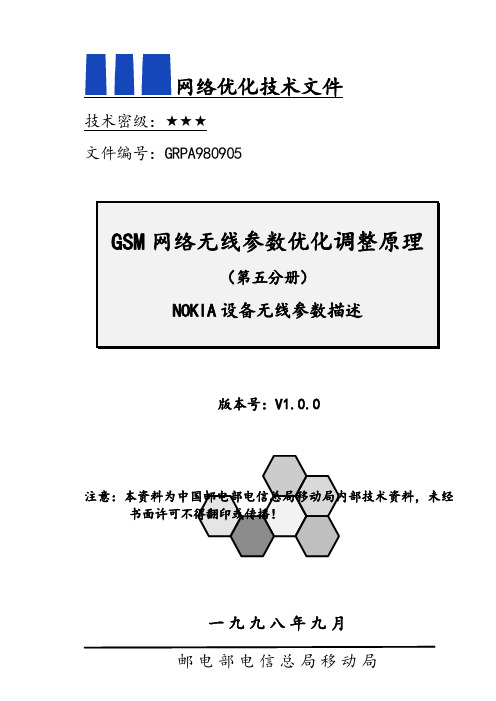
2GSM无线参数调整空页3GSM无线参数调整目录1. 前言 (11)2. 本文的研究内容 (14)3. BSC参数 (15)3.1 BSC呼叫号 (15)3.2 由于BTS机房后备电源引起的强制切换定时器 (15)3.3 DCS宏蜂窝门限 (15)3.4 DCS微蜂窝门限 (15)3.5 被叫用户特别早指配允许 (15)3.6 呼叫重建过程中特别早指配允许 (17)3.7 紧急呼叫过程中特别早指配允许 (18)3.8 主叫用户特别早指配允许 (20)3.9 GSM宏蜂窝门限 (21)3.10 GSM微蜂窝门限 (22)3.11 由于下行干扰引起切换的优先顺序 (22)3.12 由于上行干扰引起切换的优先顺序 (23)3.13 BSC全速率TCH资源的下限 (24)3.14 移动台距离处理 (25)3.15 预选小区数 (27)3.16 优先级 (28)3.17 用户类型 (28)3.18 切换时的TCH类型 (28)3.19 BSC全速率TCH资源的上限 (30)4. 移动分配频率表 (31)4.1 频率 (31)4.2 移动分配频率表识别 (32)4GSM无线参数调整4.3 BCCH频率表类型 (32)5. BCCH分配频率表 (33)5.1 频率 (33)5.2 BCCH频率表识别 (34)5.3 BCCH频率表类型 (34)6. BTS参数 (35)6.1 管理状态 (35)6.2 IMSI结合和分离允许 (35)6.3 平均周期 (36)6.4 备用的BTS色码 (37)6.5 备用的BTS跳频模式 (37)6.6 备用的跳频序列号1 (37)6.7 备用的跳频序列号2 (37)6.8 备用的MAIO偏置 (38)6.9 备用的移动分配频率表 (38)6.10 备用的网络色码 (38)6.11 对于激活MS的BCCH分配应用 (38)6.12 干扰带边界1~4 (39)6.13 基站色码 (40)6.14 BTS识别 (41)6.15 BTS跳频模式 (42)6.16 BTS负荷门限 (43)6.17 BTS测量平均周期 (44)6.18 BTS名称 (45)6.19 呼叫重建允许 (45)6.20 小区禁止限制 (46)6.21 小区接入禁止 (49)6.22 小区识别 (50)6.23 小区重选滞后 (51)6.24 小区重选偏置 (53)6.25 小区重选参数指示 (54)6.26 小区类型 (55)5GSM无线参数调整6.27 载噪比门限 (55)6.28 直接重试 (55)6.29 非连续发送 (56)6.30 双频小区 (57)6.31 早送指示 (57)6.32 紧急呼叫限制 (58)6.33 应用的频率段 (59)6.34 跳频序列号1 (59)6.35 跳频序列号2 (61)6.36 对空闲状态MS的BCCH频率表标识 (62)6.37 智能直接从事 (63)6.38 空闲TCH限制 (63)6.39 位置区码 (64)6.40 全速率TCH资源的下限 (65)6.41 移动分配索引偏置 (66)6.42 最大重复次数 (67)6.43 最大重发次数 (68)6.44 最大队列长度 (69)6.45 定向重试的最大时限 (71)6.46 定向重试的最小时限 (72)6.47 移动分配频率表 (73)6.48 移动国家号 (73)6.49 移动网号 (74)6.50 呼叫建立过程中移动台的最大距离 (76)6.51 移动台优先级应用 (77)6.52 移动台最大发射功率 (78)6.53 控制信道最大功率电平 (79)6.54 移动台最小发射功率 (81)6.55 多频段指示 (82)6.56 网络色码 (83)6.57 新建原因指示 (84)6.58 不允许接入的等级 (85)6.59 接入准许保留块数 (87)6GSM无线参数调整6.60 寻呼信道复帧数 (88)6.61 发送分布时隙数 (90)6.62 仅保留给优先用户的业务信道数 (92)6.63 惩罚时间 (92)6.64 允许的网络色码 (94)6.65 功率偏置 (95)6.66 排队优先级应用 (95)6.67 呼叫原因指配请求的排队优先级 (97)6.68 一般切换原因指配请求的排队优先级 (98)6.69 紧急切换原因指配请求的排队优先级 (99)6.70 无线链路超时 (100)6.71 半径扩展 (101)6.72 用于干线预留的保留方式 (101)6.73 优先信道对切换接入的限制应用 (101)6.74 允许接入的最小接收电平 (102)6.75 广播短消息允许 (103)6.76 干线保留门限表识别 (104)6.77 小区内切换时的TCH类型 (104)6.78 临时配置 (105)6.79 呼叫时间限制 (106)6.80 切换时间限制 (107)6.81 周期位置更新定时器 (108)6.82 业务类型 (109)6.83 干线保留算法应用 (110)6.84 TCH分配过程中的TRX优先级 (110)6.85 BTS全速率TCH资源的上限 (110)7. 邻区参数 (112)7.1 邻小区识别 (112)7.2 相邻小区层 (114)7.3 后备BCCH频率 (114)7.4 后备BTS色码 (114)7.5 后备网络色码 (115)7GSM无线参数调整7.6 BCCH频率 (115)7.7 BTS色码 (116)7.8 参考小区的小区识别 (116)7.9 小区类型 (117)7.10 链接相邻小区 (117)7.11 载干比估算加权 (117)7.12 信号电平与信号质量的切换边界 (117)7.13 快速移动门限 (117)7.14 切换负荷因子 (118)7.15 切换优先级 (118)7.16 切入伞形邻区的最低电平 (118)7.17 信号电平的切换边界 (118)7.18 功率预算的切换边界 (118)7.19 信号质量的切换边界 (119)7.20 切换目标区 (119)7.21 电平调整 (119)7.22 参考小区的位置区码 (119)7.23 移动台最佳功率电平 (119)7.24 邻区的移动台最大发射功率 (120)7.25 邻区网络色码 (120)7.26 允许切入的最小邻区接收电平 (120)7.27 同步 (121)7.28 业务原因切换的目标电平 (121)8. 切换控制参数 (123)8.1 邻区均化窗口尺寸 (123)8.2 所有邻小区平均 (124)8.3 所有干扰小区平均 (124)8.4 载干比估算方法 (124)8.5 连续快速超越门限场强的计数 (124)8.6 启用快速平均呼叫建立 (124)8.7 启用快速平均切换 (125)8.8 启用快速平均功率控制 (125)8GSM无线参数调整8.9 启用由于上行干扰引起的小区内切换 (125)8.10 启用由于下行干扰引起的小区内切换 (126)8.11 启用移动台距离处理过程 (127)8.12 启用功率预算切换 (128)8.13 启用SDCCH信道上的切换 (129)8.14 启用TCH指配超级IUO (130)8.15 允许伞状切换 (131)8.16 功率预算切换的间隔时间 (131)8.17 伞状切换的间隔时间 (132)8.18 干扰小区平均窗口尺寸 (132)8.19 干扰小区可忽略的0结果数目 (132)8.20 下行接收电平平均的窗口尺寸、权值 (132)8.21 上行接收电平平均的窗口尺寸、权值 (132)8.22 分段的载干比低限 (133)8.23 速度低限 (133)8.24 连续切换间的最小间隔时间 (134)8.25 不成功的切换请求的最小间隔 (135)8.26 从普通TRX到超级TRX切换的最小时间间隔 (136)8.27 不成功的IUO切换间的最小时间间隔 (136)8.28 最小的BSIC译码时间 (136)8.29 移动台距离平均窗口尺寸 (136)8.30 由于移动台距离原因引起的切换至扩展小区的最大门限 (137)8.31 移动台距离原因由扩展小区切换到普通小区的切换最低门限 (137)8.32 ms距离参数 (138)8.33 移动台速度平均 (139)8.34 移动台速度门限nx (139)8.35 移动台速度门限 (139)8.36 0结果数 (139)8.37 分段的优先调整步骤 (139)8.38 下行质量平均窗口尺寸、权值 (140)8.39 上行质量平均窗口尺寸、权值 (140)8.40 超级重用最低载干比门限 (140)8.41 超级重用估算方法 (140)9GSM无线参数调整8.42 超级重用最佳载干比门限 (140)8.43 下行接收干扰电平门限 (141)8.44 上行接收干扰电平门限 (141)8.45 下行接收电平门限 (141)8.46 threshold level uplink for rapid field drop(RPD)。
3GPP TS 36.331 V13.2.0 (2016-06)
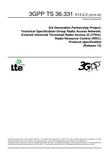
3GPP TS 36.331 V13.2.0 (2016-06)Technical Specification3rd Generation Partnership Project;Technical Specification Group Radio Access Network;Evolved Universal Terrestrial Radio Access (E-UTRA);Radio Resource Control (RRC);Protocol specification(Release 13)The present document has been developed within the 3rd Generation Partnership Project (3GPP TM) and may be further elaborated for the purposes of 3GPP. The present document has not been subject to any approval process by the 3GPP Organizational Partners and shall not be implemented.This Specification is provided for future development work within 3GPP only. The Organizational Partners accept no liability for any use of this Specification. Specifications and reports for implementation of the 3GPP TM system should be obtained via the 3GPP Organizational Partners' Publications Offices.KeywordsUMTS, radio3GPPPostal address3GPP support office address650 Route des Lucioles - Sophia AntipolisValbonne - FRANCETel.: +33 4 92 94 42 00 Fax: +33 4 93 65 47 16InternetCopyright NotificationNo part may be reproduced except as authorized by written permission.The copyright and the foregoing restriction extend to reproduction in all media.© 2016, 3GPP Organizational Partners (ARIB, ATIS, CCSA, ETSI, TSDSI, TTA, TTC).All rights reserved.UMTS™ is a Trade Mark of ETSI registered for the benefit of its members3GPP™ is a Trade Mark of ETSI registered for the benefit of its Members and of the 3GPP Organizational PartnersLTE™ is a Trade Mark of ETSI currently being registered for the benefit of its Members and of the 3GPP Organizational Partners GSM® and the GSM logo are registered and owned by the GSM AssociationBluetooth® is a Trade Mark of the Bluetooth SIG registered for the benefit of its membersContentsForeword (18)1Scope (19)2References (19)3Definitions, symbols and abbreviations (22)3.1Definitions (22)3.2Abbreviations (24)4General (27)4.1Introduction (27)4.2Architecture (28)4.2.1UE states and state transitions including inter RAT (28)4.2.2Signalling radio bearers (29)4.3Services (30)4.3.1Services provided to upper layers (30)4.3.2Services expected from lower layers (30)4.4Functions (30)5Procedures (32)5.1General (32)5.1.1Introduction (32)5.1.2General requirements (32)5.2System information (33)5.2.1Introduction (33)5.2.1.1General (33)5.2.1.2Scheduling (34)5.2.1.2a Scheduling for NB-IoT (34)5.2.1.3System information validity and notification of changes (35)5.2.1.4Indication of ETWS notification (36)5.2.1.5Indication of CMAS notification (37)5.2.1.6Notification of EAB parameters change (37)5.2.1.7Access Barring parameters change in NB-IoT (37)5.2.2System information acquisition (38)5.2.2.1General (38)5.2.2.2Initiation (38)5.2.2.3System information required by the UE (38)5.2.2.4System information acquisition by the UE (39)5.2.2.5Essential system information missing (42)5.2.2.6Actions upon reception of the MasterInformationBlock message (42)5.2.2.7Actions upon reception of the SystemInformationBlockType1 message (42)5.2.2.8Actions upon reception of SystemInformation messages (44)5.2.2.9Actions upon reception of SystemInformationBlockType2 (44)5.2.2.10Actions upon reception of SystemInformationBlockType3 (45)5.2.2.11Actions upon reception of SystemInformationBlockType4 (45)5.2.2.12Actions upon reception of SystemInformationBlockType5 (45)5.2.2.13Actions upon reception of SystemInformationBlockType6 (45)5.2.2.14Actions upon reception of SystemInformationBlockType7 (45)5.2.2.15Actions upon reception of SystemInformationBlockType8 (45)5.2.2.16Actions upon reception of SystemInformationBlockType9 (46)5.2.2.17Actions upon reception of SystemInformationBlockType10 (46)5.2.2.18Actions upon reception of SystemInformationBlockType11 (46)5.2.2.19Actions upon reception of SystemInformationBlockType12 (47)5.2.2.20Actions upon reception of SystemInformationBlockType13 (48)5.2.2.21Actions upon reception of SystemInformationBlockType14 (48)5.2.2.22Actions upon reception of SystemInformationBlockType15 (48)5.2.2.23Actions upon reception of SystemInformationBlockType16 (48)5.2.2.24Actions upon reception of SystemInformationBlockType17 (48)5.2.2.25Actions upon reception of SystemInformationBlockType18 (48)5.2.2.26Actions upon reception of SystemInformationBlockType19 (49)5.2.3Acquisition of an SI message (49)5.2.3a Acquisition of an SI message by BL UE or UE in CE or a NB-IoT UE (50)5.3Connection control (50)5.3.1Introduction (50)5.3.1.1RRC connection control (50)5.3.1.2Security (52)5.3.1.2a RN security (53)5.3.1.3Connected mode mobility (53)5.3.1.4Connection control in NB-IoT (54)5.3.2Paging (55)5.3.2.1General (55)5.3.2.2Initiation (55)5.3.2.3Reception of the Paging message by the UE (55)5.3.3RRC connection establishment (56)5.3.3.1General (56)5.3.3.1a Conditions for establishing RRC Connection for sidelink communication/ discovery (58)5.3.3.2Initiation (59)5.3.3.3Actions related to transmission of RRCConnectionRequest message (63)5.3.3.3a Actions related to transmission of RRCConnectionResumeRequest message (64)5.3.3.4Reception of the RRCConnectionSetup by the UE (64)5.3.3.4a Reception of the RRCConnectionResume by the UE (66)5.3.3.5Cell re-selection while T300, T302, T303, T305, T306, or T308 is running (68)5.3.3.6T300 expiry (68)5.3.3.7T302, T303, T305, T306, or T308 expiry or stop (69)5.3.3.8Reception of the RRCConnectionReject by the UE (70)5.3.3.9Abortion of RRC connection establishment (71)5.3.3.10Handling of SSAC related parameters (71)5.3.3.11Access barring check (72)5.3.3.12EAB check (73)5.3.3.13Access barring check for ACDC (73)5.3.3.14Access Barring check for NB-IoT (74)5.3.4Initial security activation (75)5.3.4.1General (75)5.3.4.2Initiation (76)5.3.4.3Reception of the SecurityModeCommand by the UE (76)5.3.5RRC connection reconfiguration (77)5.3.5.1General (77)5.3.5.2Initiation (77)5.3.5.3Reception of an RRCConnectionReconfiguration not including the mobilityControlInfo by theUE (77)5.3.5.4Reception of an RRCConnectionReconfiguration including the mobilityControlInfo by the UE(handover) (79)5.3.5.5Reconfiguration failure (83)5.3.5.6T304 expiry (handover failure) (83)5.3.5.7Void (84)5.3.5.7a T307 expiry (SCG change failure) (84)5.3.5.8Radio Configuration involving full configuration option (84)5.3.6Counter check (86)5.3.6.1General (86)5.3.6.2Initiation (86)5.3.6.3Reception of the CounterCheck message by the UE (86)5.3.7RRC connection re-establishment (87)5.3.7.1General (87)5.3.7.2Initiation (87)5.3.7.3Actions following cell selection while T311 is running (88)5.3.7.4Actions related to transmission of RRCConnectionReestablishmentRequest message (89)5.3.7.5Reception of the RRCConnectionReestablishment by the UE (89)5.3.7.6T311 expiry (91)5.3.7.7T301 expiry or selected cell no longer suitable (91)5.3.7.8Reception of RRCConnectionReestablishmentReject by the UE (91)5.3.8RRC connection release (92)5.3.8.1General (92)5.3.8.2Initiation (92)5.3.8.3Reception of the RRCConnectionRelease by the UE (92)5.3.8.4T320 expiry (93)5.3.9RRC connection release requested by upper layers (93)5.3.9.1General (93)5.3.9.2Initiation (93)5.3.10Radio resource configuration (93)5.3.10.0General (93)5.3.10.1SRB addition/ modification (94)5.3.10.2DRB release (95)5.3.10.3DRB addition/ modification (95)5.3.10.3a1DC specific DRB addition or reconfiguration (96)5.3.10.3a2LWA specific DRB addition or reconfiguration (98)5.3.10.3a3LWIP specific DRB addition or reconfiguration (98)5.3.10.3a SCell release (99)5.3.10.3b SCell addition/ modification (99)5.3.10.3c PSCell addition or modification (99)5.3.10.4MAC main reconfiguration (99)5.3.10.5Semi-persistent scheduling reconfiguration (100)5.3.10.6Physical channel reconfiguration (100)5.3.10.7Radio Link Failure Timers and Constants reconfiguration (101)5.3.10.8Time domain measurement resource restriction for serving cell (101)5.3.10.9Other configuration (102)5.3.10.10SCG reconfiguration (103)5.3.10.11SCG dedicated resource configuration (104)5.3.10.12Reconfiguration SCG or split DRB by drb-ToAddModList (105)5.3.10.13Neighbour cell information reconfiguration (105)5.3.10.14Void (105)5.3.10.15Sidelink dedicated configuration (105)5.3.10.16T370 expiry (106)5.3.11Radio link failure related actions (107)5.3.11.1Detection of physical layer problems in RRC_CONNECTED (107)5.3.11.2Recovery of physical layer problems (107)5.3.11.3Detection of radio link failure (107)5.3.12UE actions upon leaving RRC_CONNECTED (109)5.3.13UE actions upon PUCCH/ SRS release request (110)5.3.14Proximity indication (110)5.3.14.1General (110)5.3.14.2Initiation (111)5.3.14.3Actions related to transmission of ProximityIndication message (111)5.3.15Void (111)5.4Inter-RAT mobility (111)5.4.1Introduction (111)5.4.2Handover to E-UTRA (112)5.4.2.1General (112)5.4.2.2Initiation (112)5.4.2.3Reception of the RRCConnectionReconfiguration by the UE (112)5.4.2.4Reconfiguration failure (114)5.4.2.5T304 expiry (handover to E-UTRA failure) (114)5.4.3Mobility from E-UTRA (114)5.4.3.1General (114)5.4.3.2Initiation (115)5.4.3.3Reception of the MobilityFromEUTRACommand by the UE (115)5.4.3.4Successful completion of the mobility from E-UTRA (116)5.4.3.5Mobility from E-UTRA failure (117)5.4.4Handover from E-UTRA preparation request (CDMA2000) (117)5.4.4.1General (117)5.4.4.2Initiation (118)5.4.4.3Reception of the HandoverFromEUTRAPreparationRequest by the UE (118)5.4.5UL handover preparation transfer (CDMA2000) (118)5.4.5.1General (118)5.4.5.2Initiation (118)5.4.5.3Actions related to transmission of the ULHandoverPreparationTransfer message (119)5.4.5.4Failure to deliver the ULHandoverPreparationTransfer message (119)5.4.6Inter-RAT cell change order to E-UTRAN (119)5.4.6.1General (119)5.4.6.2Initiation (119)5.4.6.3UE fails to complete an inter-RAT cell change order (119)5.5Measurements (120)5.5.1Introduction (120)5.5.2Measurement configuration (121)5.5.2.1General (121)5.5.2.2Measurement identity removal (122)5.5.2.2a Measurement identity autonomous removal (122)5.5.2.3Measurement identity addition/ modification (123)5.5.2.4Measurement object removal (124)5.5.2.5Measurement object addition/ modification (124)5.5.2.6Reporting configuration removal (126)5.5.2.7Reporting configuration addition/ modification (127)5.5.2.8Quantity configuration (127)5.5.2.9Measurement gap configuration (127)5.5.2.10Discovery signals measurement timing configuration (128)5.5.2.11RSSI measurement timing configuration (128)5.5.3Performing measurements (128)5.5.3.1General (128)5.5.3.2Layer 3 filtering (131)5.5.4Measurement report triggering (131)5.5.4.1General (131)5.5.4.2Event A1 (Serving becomes better than threshold) (135)5.5.4.3Event A2 (Serving becomes worse than threshold) (136)5.5.4.4Event A3 (Neighbour becomes offset better than PCell/ PSCell) (136)5.5.4.5Event A4 (Neighbour becomes better than threshold) (137)5.5.4.6Event A5 (PCell/ PSCell becomes worse than threshold1 and neighbour becomes better thanthreshold2) (138)5.5.4.6a Event A6 (Neighbour becomes offset better than SCell) (139)5.5.4.7Event B1 (Inter RAT neighbour becomes better than threshold) (139)5.5.4.8Event B2 (PCell becomes worse than threshold1 and inter RAT neighbour becomes better thanthreshold2) (140)5.5.4.9Event C1 (CSI-RS resource becomes better than threshold) (141)5.5.4.10Event C2 (CSI-RS resource becomes offset better than reference CSI-RS resource) (141)5.5.4.11Event W1 (WLAN becomes better than a threshold) (142)5.5.4.12Event W2 (All WLAN inside WLAN mobility set becomes worse than threshold1 and a WLANoutside WLAN mobility set becomes better than threshold2) (142)5.5.4.13Event W3 (All WLAN inside WLAN mobility set becomes worse than a threshold) (143)5.5.5Measurement reporting (144)5.5.6Measurement related actions (148)5.5.6.1Actions upon handover and re-establishment (148)5.5.6.2Speed dependant scaling of measurement related parameters (149)5.5.7Inter-frequency RSTD measurement indication (149)5.5.7.1General (149)5.5.7.2Initiation (150)5.5.7.3Actions related to transmission of InterFreqRSTDMeasurementIndication message (150)5.6Other (150)5.6.0General (150)5.6.1DL information transfer (151)5.6.1.1General (151)5.6.1.2Initiation (151)5.6.1.3Reception of the DLInformationTransfer by the UE (151)5.6.2UL information transfer (151)5.6.2.1General (151)5.6.2.2Initiation (151)5.6.2.3Actions related to transmission of ULInformationTransfer message (152)5.6.2.4Failure to deliver ULInformationTransfer message (152)5.6.3UE capability transfer (152)5.6.3.1General (152)5.6.3.2Initiation (153)5.6.3.3Reception of the UECapabilityEnquiry by the UE (153)5.6.4CSFB to 1x Parameter transfer (157)5.6.4.1General (157)5.6.4.2Initiation (157)5.6.4.3Actions related to transmission of CSFBParametersRequestCDMA2000 message (157)5.6.4.4Reception of the CSFBParametersResponseCDMA2000 message (157)5.6.5UE Information (158)5.6.5.1General (158)5.6.5.2Initiation (158)5.6.5.3Reception of the UEInformationRequest message (158)5.6.6 Logged Measurement Configuration (159)5.6.6.1General (159)5.6.6.2Initiation (160)5.6.6.3Reception of the LoggedMeasurementConfiguration by the UE (160)5.6.6.4T330 expiry (160)5.6.7 Release of Logged Measurement Configuration (160)5.6.7.1General (160)5.6.7.2Initiation (160)5.6.8 Measurements logging (161)5.6.8.1General (161)5.6.8.2Initiation (161)5.6.9In-device coexistence indication (163)5.6.9.1General (163)5.6.9.2Initiation (164)5.6.9.3Actions related to transmission of InDeviceCoexIndication message (164)5.6.10UE Assistance Information (165)5.6.10.1General (165)5.6.10.2Initiation (166)5.6.10.3Actions related to transmission of UEAssistanceInformation message (166)5.6.11 Mobility history information (166)5.6.11.1General (166)5.6.11.2Initiation (166)5.6.12RAN-assisted WLAN interworking (167)5.6.12.1General (167)5.6.12.2Dedicated WLAN offload configuration (167)5.6.12.3WLAN offload RAN evaluation (167)5.6.12.4T350 expiry or stop (167)5.6.12.5Cell selection/ re-selection while T350 is running (168)5.6.13SCG failure information (168)5.6.13.1General (168)5.6.13.2Initiation (168)5.6.13.3Actions related to transmission of SCGFailureInformation message (168)5.6.14LTE-WLAN Aggregation (169)5.6.14.1Introduction (169)5.6.14.2Reception of LWA configuration (169)5.6.14.3Release of LWA configuration (170)5.6.15WLAN connection management (170)5.6.15.1Introduction (170)5.6.15.2WLAN connection status reporting (170)5.6.15.2.1General (170)5.6.15.2.2Initiation (171)5.6.15.2.3Actions related to transmission of WLANConnectionStatusReport message (171)5.6.15.3T351 Expiry (WLAN connection attempt timeout) (171)5.6.15.4WLAN status monitoring (171)5.6.16RAN controlled LTE-WLAN interworking (172)5.6.16.1General (172)5.6.16.2WLAN traffic steering command (172)5.6.17LTE-WLAN aggregation with IPsec tunnel (173)5.6.17.1General (173)5.7Generic error handling (174)5.7.1General (174)5.7.2ASN.1 violation or encoding error (174)5.7.3Field set to a not comprehended value (174)5.7.4Mandatory field missing (174)5.7.5Not comprehended field (176)5.8MBMS (176)5.8.1Introduction (176)5.8.1.1General (176)5.8.1.2Scheduling (176)5.8.1.3MCCH information validity and notification of changes (176)5.8.2MCCH information acquisition (178)5.8.2.1General (178)5.8.2.2Initiation (178)5.8.2.3MCCH information acquisition by the UE (178)5.8.2.4Actions upon reception of the MBSFNAreaConfiguration message (178)5.8.2.5Actions upon reception of the MBMSCountingRequest message (179)5.8.3MBMS PTM radio bearer configuration (179)5.8.3.1General (179)5.8.3.2Initiation (179)5.8.3.3MRB establishment (179)5.8.3.4MRB release (179)5.8.4MBMS Counting Procedure (179)5.8.4.1General (179)5.8.4.2Initiation (180)5.8.4.3Reception of the MBMSCountingRequest message by the UE (180)5.8.5MBMS interest indication (181)5.8.5.1General (181)5.8.5.2Initiation (181)5.8.5.3Determine MBMS frequencies of interest (182)5.8.5.4Actions related to transmission of MBMSInterestIndication message (183)5.8a SC-PTM (183)5.8a.1Introduction (183)5.8a.1.1General (183)5.8a.1.2SC-MCCH scheduling (183)5.8a.1.3SC-MCCH information validity and notification of changes (183)5.8a.1.4Procedures (184)5.8a.2SC-MCCH information acquisition (184)5.8a.2.1General (184)5.8a.2.2Initiation (184)5.8a.2.3SC-MCCH information acquisition by the UE (184)5.8a.2.4Actions upon reception of the SCPTMConfiguration message (185)5.8a.3SC-PTM radio bearer configuration (185)5.8a.3.1General (185)5.8a.3.2Initiation (185)5.8a.3.3SC-MRB establishment (185)5.8a.3.4SC-MRB release (185)5.9RN procedures (186)5.9.1RN reconfiguration (186)5.9.1.1General (186)5.9.1.2Initiation (186)5.9.1.3Reception of the RNReconfiguration by the RN (186)5.10Sidelink (186)5.10.1Introduction (186)5.10.1a Conditions for sidelink communication operation (187)5.10.2Sidelink UE information (188)5.10.2.1General (188)5.10.2.2Initiation (189)5.10.2.3Actions related to transmission of SidelinkUEInformation message (193)5.10.3Sidelink communication monitoring (195)5.10.6Sidelink discovery announcement (198)5.10.6a Sidelink discovery announcement pool selection (201)5.10.6b Sidelink discovery announcement reference carrier selection (201)5.10.7Sidelink synchronisation information transmission (202)5.10.7.1General (202)5.10.7.2Initiation (203)5.10.7.3Transmission of SLSS (204)5.10.7.4Transmission of MasterInformationBlock-SL message (205)5.10.7.5Void (206)5.10.8Sidelink synchronisation reference (206)5.10.8.1General (206)5.10.8.2Selection and reselection of synchronisation reference UE (SyncRef UE) (206)5.10.9Sidelink common control information (207)5.10.9.1General (207)5.10.9.2Actions related to reception of MasterInformationBlock-SL message (207)5.10.10Sidelink relay UE operation (207)5.10.10.1General (207)5.10.10.2AS-conditions for relay related sidelink communication transmission by sidelink relay UE (207)5.10.10.3AS-conditions for relay PS related sidelink discovery transmission by sidelink relay UE (208)5.10.10.4Sidelink relay UE threshold conditions (208)5.10.11Sidelink remote UE operation (208)5.10.11.1General (208)5.10.11.2AS-conditions for relay related sidelink communication transmission by sidelink remote UE (208)5.10.11.3AS-conditions for relay PS related sidelink discovery transmission by sidelink remote UE (209)5.10.11.4Selection and reselection of sidelink relay UE (209)5.10.11.5Sidelink remote UE threshold conditions (210)6Protocol data units, formats and parameters (tabular & ASN.1) (210)6.1General (210)6.2RRC messages (212)6.2.1General message structure (212)–EUTRA-RRC-Definitions (212)–BCCH-BCH-Message (212)–BCCH-DL-SCH-Message (212)–BCCH-DL-SCH-Message-BR (213)–MCCH-Message (213)–PCCH-Message (213)–DL-CCCH-Message (214)–DL-DCCH-Message (214)–UL-CCCH-Message (214)–UL-DCCH-Message (215)–SC-MCCH-Message (215)6.2.2Message definitions (216)–CounterCheck (216)–CounterCheckResponse (217)–CSFBParametersRequestCDMA2000 (217)–CSFBParametersResponseCDMA2000 (218)–DLInformationTransfer (218)–HandoverFromEUTRAPreparationRequest (CDMA2000) (219)–InDeviceCoexIndication (220)–InterFreqRSTDMeasurementIndication (222)–LoggedMeasurementConfiguration (223)–MasterInformationBlock (225)–MBMSCountingRequest (226)–MBMSCountingResponse (226)–MBMSInterestIndication (227)–MBSFNAreaConfiguration (228)–MeasurementReport (228)–MobilityFromEUTRACommand (229)–Paging (232)–ProximityIndication (233)–RNReconfiguration (234)–RNReconfigurationComplete (234)–RRCConnectionReconfiguration (235)–RRCConnectionReconfigurationComplete (240)–RRCConnectionReestablishment (241)–RRCConnectionReestablishmentComplete (241)–RRCConnectionReestablishmentReject (242)–RRCConnectionReestablishmentRequest (243)–RRCConnectionReject (243)–RRCConnectionRelease (244)–RRCConnectionResume (248)–RRCConnectionResumeComplete (249)–RRCConnectionResumeRequest (250)–RRCConnectionRequest (250)–RRCConnectionSetup (251)–RRCConnectionSetupComplete (252)–SCGFailureInformation (253)–SCPTMConfiguration (254)–SecurityModeCommand (255)–SecurityModeComplete (255)–SecurityModeFailure (256)–SidelinkUEInformation (256)–SystemInformation (258)–SystemInformationBlockType1 (259)–UEAssistanceInformation (264)–UECapabilityEnquiry (265)–UECapabilityInformation (266)–UEInformationRequest (267)–UEInformationResponse (267)–ULHandoverPreparationTransfer (CDMA2000) (273)–ULInformationTransfer (274)–WLANConnectionStatusReport (274)6.3RRC information elements (275)6.3.1System information blocks (275)–SystemInformationBlockType2 (275)–SystemInformationBlockType3 (279)–SystemInformationBlockType4 (282)–SystemInformationBlockType5 (283)–SystemInformationBlockType6 (287)–SystemInformationBlockType7 (289)–SystemInformationBlockType8 (290)–SystemInformationBlockType9 (295)–SystemInformationBlockType10 (295)–SystemInformationBlockType11 (296)–SystemInformationBlockType12 (297)–SystemInformationBlockType13 (297)–SystemInformationBlockType14 (298)–SystemInformationBlockType15 (298)–SystemInformationBlockType16 (299)–SystemInformationBlockType17 (300)–SystemInformationBlockType18 (301)–SystemInformationBlockType19 (301)–SystemInformationBlockType20 (304)6.3.2Radio resource control information elements (304)–AntennaInfo (304)–AntennaInfoUL (306)–CQI-ReportConfig (307)–CQI-ReportPeriodicProcExtId (314)–CrossCarrierSchedulingConfig (314)–CSI-IM-Config (315)–CSI-IM-ConfigId (315)–CSI-RS-Config (317)–CSI-RS-ConfigEMIMO (318)–CSI-RS-ConfigNZP (319)–CSI-RS-ConfigNZPId (320)–CSI-RS-ConfigZP (321)–CSI-RS-ConfigZPId (321)–DMRS-Config (321)–DRB-Identity (322)–EPDCCH-Config (322)–EIMTA-MainConfig (324)–LogicalChannelConfig (325)–LWA-Configuration (326)–LWIP-Configuration (326)–RCLWI-Configuration (327)–MAC-MainConfig (327)–P-C-AndCBSR (332)–PDCCH-ConfigSCell (333)–PDCP-Config (334)–PDSCH-Config (337)–PDSCH-RE-MappingQCL-ConfigId (339)–PHICH-Config (339)–PhysicalConfigDedicated (339)–P-Max (344)–PRACH-Config (344)–PresenceAntennaPort1 (346)–PUCCH-Config (347)–PUSCH-Config (351)–RACH-ConfigCommon (355)–RACH-ConfigDedicated (357)–RadioResourceConfigCommon (358)–RadioResourceConfigDedicated (362)–RLC-Config (367)–RLF-TimersAndConstants (369)–RN-SubframeConfig (370)–SchedulingRequestConfig (371)–SoundingRS-UL-Config (372)–SPS-Config (375)–TDD-Config (376)–TimeAlignmentTimer (377)–TPC-PDCCH-Config (377)–TunnelConfigLWIP (378)–UplinkPowerControl (379)–WLAN-Id-List (382)–WLAN-MobilityConfig (382)6.3.3Security control information elements (382)–NextHopChainingCount (382)–SecurityAlgorithmConfig (383)–ShortMAC-I (383)6.3.4Mobility control information elements (383)–AdditionalSpectrumEmission (383)–ARFCN-ValueCDMA2000 (383)–ARFCN-ValueEUTRA (384)–ARFCN-ValueGERAN (384)–ARFCN-ValueUTRA (384)–BandclassCDMA2000 (384)–BandIndicatorGERAN (385)–CarrierFreqCDMA2000 (385)–CarrierFreqGERAN (385)–CellIndexList (387)–CellReselectionPriority (387)–CellSelectionInfoCE (387)–CellReselectionSubPriority (388)–CSFB-RegistrationParam1XRTT (388)–CellGlobalIdEUTRA (389)–CellGlobalIdUTRA (389)–CellGlobalIdGERAN (390)–CellGlobalIdCDMA2000 (390)–CellSelectionInfoNFreq (391)–CSG-Identity (391)–FreqBandIndicator (391)–MobilityControlInfo (391)–MobilityParametersCDMA2000 (1xRTT) (393)–MobilityStateParameters (394)–MultiBandInfoList (394)–NS-PmaxList (394)–PhysCellId (395)–PhysCellIdRange (395)–PhysCellIdRangeUTRA-FDDList (395)–PhysCellIdCDMA2000 (396)–PhysCellIdGERAN (396)–PhysCellIdUTRA-FDD (396)–PhysCellIdUTRA-TDD (396)–PLMN-Identity (397)–PLMN-IdentityList3 (397)–PreRegistrationInfoHRPD (397)–Q-QualMin (398)–Q-RxLevMin (398)–Q-OffsetRange (398)–Q-OffsetRangeInterRAT (399)–ReselectionThreshold (399)–ReselectionThresholdQ (399)–SCellIndex (399)–ServCellIndex (400)–SpeedStateScaleFactors (400)–SystemInfoListGERAN (400)–SystemTimeInfoCDMA2000 (401)–TrackingAreaCode (401)–T-Reselection (402)–T-ReselectionEUTRA-CE (402)6.3.5Measurement information elements (402)–AllowedMeasBandwidth (402)–CSI-RSRP-Range (402)–Hysteresis (402)–LocationInfo (403)–MBSFN-RSRQ-Range (403)–MeasConfig (404)–MeasDS-Config (405)–MeasGapConfig (406)–MeasId (407)–MeasIdToAddModList (407)–MeasObjectCDMA2000 (408)–MeasObjectEUTRA (408)–MeasObjectGERAN (412)–MeasObjectId (412)–MeasObjectToAddModList (412)–MeasObjectUTRA (413)–ReportConfigEUTRA (422)–ReportConfigId (425)–ReportConfigInterRAT (425)–ReportConfigToAddModList (428)–ReportInterval (429)–RSRP-Range (429)–RSRQ-Range (430)–RSRQ-Type (430)–RS-SINR-Range (430)–RSSI-Range-r13 (431)–TimeToTrigger (431)–UL-DelayConfig (431)–WLAN-CarrierInfo (431)–WLAN-RSSI-Range (432)–WLAN-Status (432)6.3.6Other information elements (433)–AbsoluteTimeInfo (433)–AreaConfiguration (433)–C-RNTI (433)–DedicatedInfoCDMA2000 (434)–DedicatedInfoNAS (434)–FilterCoefficient (434)–LoggingDuration (434)–LoggingInterval (435)–MeasSubframePattern (435)–MMEC (435)–NeighCellConfig (435)–OtherConfig (436)–RAND-CDMA2000 (1xRTT) (437)–RAT-Type (437)–ResumeIdentity (437)–RRC-TransactionIdentifier (438)–S-TMSI (438)–TraceReference (438)–UE-CapabilityRAT-ContainerList (438)–UE-EUTRA-Capability (439)–UE-RadioPagingInfo (469)–UE-TimersAndConstants (469)–VisitedCellInfoList (470)–WLAN-OffloadConfig (470)6.3.7MBMS information elements (472)–MBMS-NotificationConfig (472)–MBMS-ServiceList (473)–MBSFN-AreaId (473)–MBSFN-AreaInfoList (473)–MBSFN-SubframeConfig (474)–PMCH-InfoList (475)6.3.7a SC-PTM information elements (476)–SC-MTCH-InfoList (476)–SCPTM-NeighbourCellList (478)6.3.8Sidelink information elements (478)–SL-CommConfig (478)–SL-CommResourcePool (479)–SL-CP-Len (480)–SL-DiscConfig (481)–SL-DiscResourcePool (483)–SL-DiscTxPowerInfo (485)–SL-GapConfig (485)。
纹理物体缺陷的视觉检测算法研究--优秀毕业论文
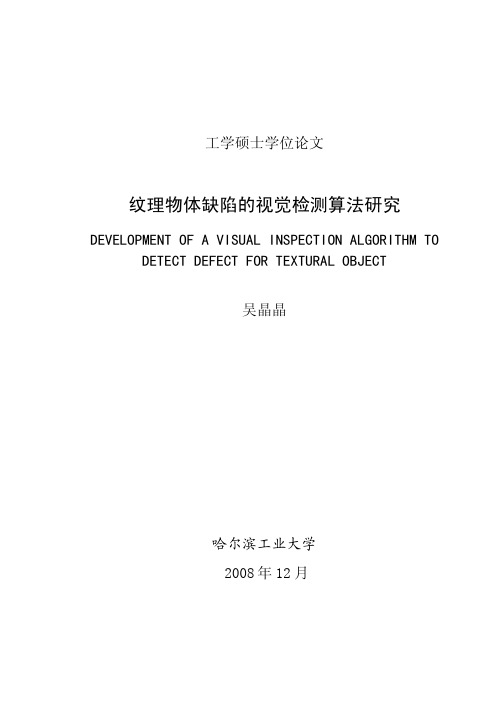
摘 要
在竞争激烈的工业自动化生产过程中,机器视觉对产品质量的把关起着举足 轻重的作用,机器视觉在缺陷检测技术方面的应用也逐渐普遍起来。与常规的检 测技术相比,自动化的视觉检测系统更加经济、快捷、高效与 安全。纹理物体在 工业生产中广泛存在,像用于半导体装配和封装底板和发光二极管,现代 化电子 系统中的印制电路板,以及纺织行业中的布匹和织物等都可认为是含有纹理特征 的物体。本论文主要致力于纹理物体的缺陷检测技术研究,为纹理物体的自动化 检测提供高效而可靠的检测算法。 纹理是描述图像内容的重要特征,纹理分析也已经被成功的应用与纹理分割 和纹理分类当中。本研究提出了一种基于纹理分析技术和参考比较方式的缺陷检 测算法。这种算法能容忍物体变形引起的图像配准误差,对纹理的影响也具有鲁 棒性。本算法旨在为检测出的缺陷区域提供丰富而重要的物理意义,如缺陷区域 的大小、形状、亮度对比度及空间分布等。同时,在参考图像可行的情况下,本 算法可用于同质纹理物体和非同质纹理物体的检测,对非纹理物体 的检测也可取 得不错的效果。 在整个检测过程中,我们采用了可调控金字塔的纹理分析和重构技术。与传 统的小波纹理分析技术不同,我们在小波域中加入处理物体变形和纹理影响的容 忍度控制算法,来实现容忍物体变形和对纹理影响鲁棒的目的。最后可调控金字 塔的重构保证了缺陷区域物理意义恢复的准确性。实验阶段,我们检测了一系列 具有实际应用价值的图像。实验结果表明 本文提出的纹理物体缺陷检测算法具有 高效性和易于实现性。 关键字: 缺陷检测;纹理;物体变形;可调控金字塔;重构
Keywords: defect detection, texture, object distortion, steerable pyramid, reconstruction
II
lightGCN
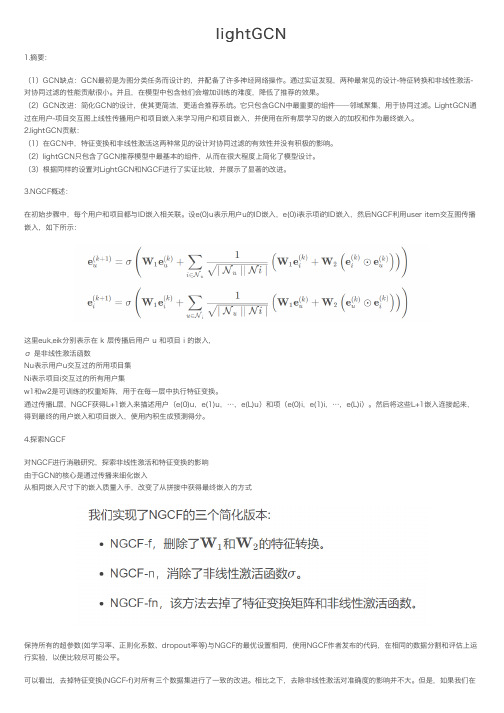
lightGCN1.摘要:(1)GCN缺点:GCN最初是为图分类任务⽽设计的,并配备了许多神经⽹络操作。
通过实证发现,两种最常见的设计-特征转换和⾮线性激活-对协同过滤的性能贡献很⼩。
并且,在模型中包含他们会增加训练的难度,降低了推荐的效果。
(2)GCN改进:简化GCN的设计,使其更简洁,更适合推荐系统。
它只包含GCN中最重要的组件——邻域聚集,⽤于协同过滤。
LightGCN通过在⽤户-项⽬交互图上线性传播⽤户和项⽬嵌⼊来学习⽤户和项⽬嵌⼊,并使⽤在所有层学习的嵌⼊的加权和作为最终嵌⼊。
2.lightGCN贡献:(1)在GCN中,特征变换和⾮线性激活这两种常见的设计对协同过滤的有效性并没有积极的影响。
(2)lightGCN只包含了GCN推荐模型中最基本的组件,从⽽在很⼤程度上简化了模型设计。
(3)根据同样的设置对LightGCN和NGCF进⾏了实证⽐较,并展⽰了显著的改进。
3.NGCF概述:在初始步骤中,每个⽤户和项⽬都与ID嵌⼊相关联。
设e(0)u表⽰⽤户u的ID嵌⼊,e(0)i表⽰项i的ID嵌⼊,然后NGCF利⽤user item交互图传播嵌⼊,如下所⽰:这⾥euk,eik分别表⽰在 k 层传播后⽤户 u 和项⽬ i 的嵌⼊,σ 是⾮线性激活函数Nu表⽰⽤户u交互过的所⽤项⽬集Ni表⽰项⽬i交互过的所有⽤户集w1和w2是可训练的权重矩阵,⽤于在每⼀层中执⾏特征变换。
通过传播L层,NGCF获得L+1嵌⼊来描述⽤户(e(0)u,e(1)u,…,e(L)u)和项(e(0)i,e(1)i,…,e(L)i)。
然后将这些L+1嵌⼊连接起来,得到最终的⽤户嵌⼊和项⽬嵌⼊,使⽤内积⽣成预测得分。
4.探索NGCF对NGCF进⾏消融研究,探索⾮线性激活和特征变换的影响由于GCN的核⼼是通过传播来细化嵌⼊从相同嵌⼊尺⼨下的嵌⼊质量⼊⼿,改变了从拼接中获得最终嵌⼊的⽅式保持所有的超参数(如学习率、正则化系数、dropout率等)与NGCF的最优设置相同,使⽤NGCF作者发布的代码,在相同的数据分割和评估上运⾏实验,以使⽐较尽可能公平。
NCEP数据资料获取地面抬升指数
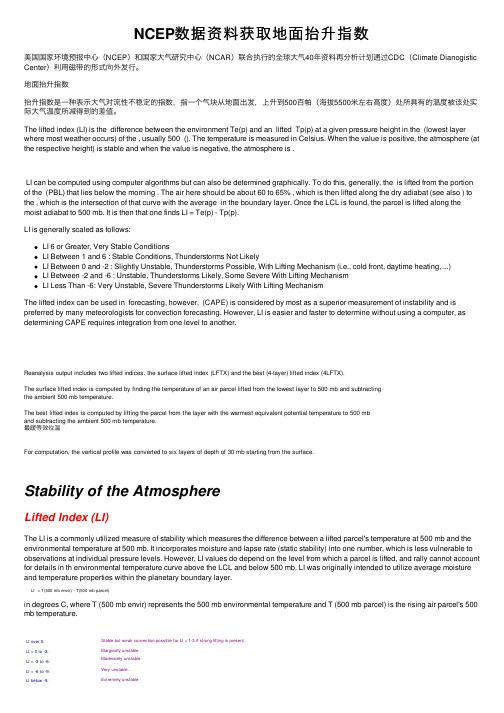
NCEP数据资料获取地⾯抬升指数美国国家环境预报中⼼(NCEP)和国家⼤⽓研究中⼼(NCAR)联合执⾏的全球⼤⽓40年资料再分析计划通过CDC(Climate Dianogistic Center)利⽤磁带的形式向外发⾏。
地⾯抬升指数抬升指数是⼀种表⽰⼤⽓对流性不稳定的指数,指⼀个⽓块从地⾯出发,上升到500百帕(海拔5500⽶左右⾼度)处所具有的温度被该处实际⼤⽓温度所减得到的差值。
The lifted index (LI) is the difference between the environment Te(p) and an lifted Tp(p) at a given pressure height in the (lowest layer where most weather occurs) of the , usually 500 (). The temperature is measured in Celsius. When the value is positive, the atmosphere (at the respective height) is stable and when the value is negative, the atmosphere is .LI can be computed using computer algorithms but can also be determined graphically. To do this, generally, the is lifted from the portion of the (PBL) that lies below the morning . The air here should be about 60 to 65% , which is then lifted along the dry adiabat (see also ) to the , which is the intersection of that curve with the average in the boundary layer. Once the LCL is found, the parcel is lifted along the moist adiabat to 500 mb. It is then that one finds LI = Te(p) - Tp(p).LI is generally scaled as follows:LI 6 or Greater, Very Stable ConditionsLI Between 1 and 6 : Stable Conditions, Thunderstorms Not LikelyLI Between 0 and -2 : Slightly Unstable, Thunderstorms Possible, With Lifting Mechanism (i.e., cold front, daytime heating, ...)LI Between -2 and -6 : Unstable, Thunderstorms Likely, Some Severe With Lifting MechanismLI Less Than -6: Very Unstable, Severe Thunderstorms Likely With Lifting MechanismThe lifted index can be used in forecasting, however, (CAPE) is considered by most as a superior measurement of instability and is preferred by many meteorologists for convection forecasting. However, LI is easier and faster to determine without using a computer, as determining CAPE requires integration from one level to another.Reanalysis output includes two lifted indices. the surface lifted index (LFTX) and the best (4-layer) lifted index (4LFTX).The surface lifted index is computed by finding the temperature of an air parcel lifted from the lowest layer to 500 mb and subtractingthe ambient 500 mb temperature.The best lifted index is computed by lifting the parcel from the layer with the warmest equivalent potential temperature to 500 mband subtracting the ambient 500 mb temperature.最暖等效位温For computation, the vertical profile was converted to six layers of depth of 30 mb starting from the surface.Stability of the AtmosphereLifted Index (LI)The LI is a commonly utilized measure of stability which measures the difference between a lifted parcel's temperature at 500 mb and the environmental temperature at 500 mb. It incorporates moisture and lapse rate (static stability) into one number, which is less vulnerable to observations at individual pressure levels. However, LI values do depend on the level from which a parcel is lifted, and rally cannot account for details in th environmental temperature curve above the LCL and below 500 mb. LI was originally intended to utilize average moisture and temperature properties within the planetary boundary layer.LI = T(500 mb envir) - T(500 mb parcel)in degrees C, where T (500 mb envir) represents the 500 mb environmental temperature and T (500 mb parcel) is the rising air parcel's 500 mb temperature.LI over 0:Stable but weak convection possible for LI = 1-3 if strong lifting is present.LI = 0 to -3:Marginally unstable.Moderately unstable.LI = -3 to -6:LI = -6 to -9:Very unstable.LI below -9:Extremely unstable.These LI values are based on lifted parcels using the average lowest 50 to 100 mb moisture and temperature values (i.e., the boundary layer). Variations exist on how LI values are calculated, as discussed below.Surfaced-based LI:Surface-based LIs can be calculated hourly, and assume a parcel is lifted from the surface using surface-based moisture and temperature values, as well as assigned environmental temperatures at 500 mb. This method is valid for a well-mixed nearly dry adiabatic afternoon boundary layer where surface characteristics are similar to those in the lowest 50 to 100 mb layer. However, these values would not be representative of the ambient elevated instability if a nocturnal inversion or shallow cool air to the north of a frontal boundary is present. In these cases, more instability resides above the surface, and parcels may be lifted to form thunderstorms from the top of the inversion.Best LI:The Best LI represents the lowest (most unstable) LI computed from a series of levels from the surface to about 850 mb. This index is most useful during cases when shallow cool air exists north of a frontal boundary resulting in surface conditions and boundary layer-based LI values that are relatively stable. However, the airmass at the top of the inversion, from which lifting may occur, is potentially unstable. An example of this would be elevated ("overrunning") convection (possibly a nocturnal MCS).。
GSM0710中文版
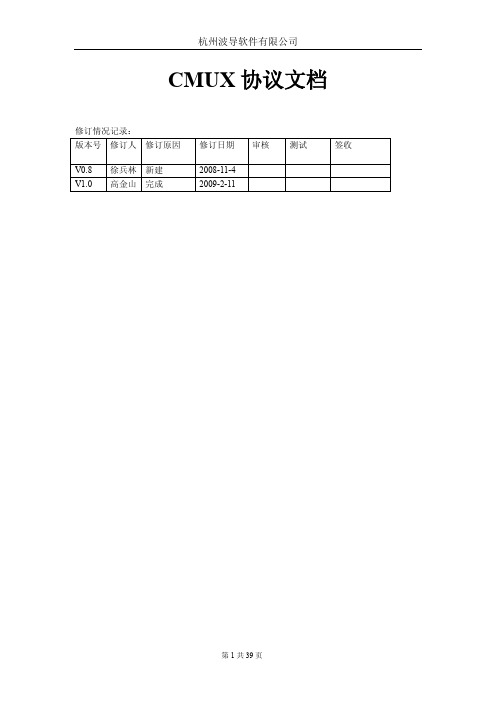
杭州波导软件有限公司
3.4. 过程和状态..................................................................................................................... 20 3.4.1. 建立 DLC 链路 ........................................................................................ 20 3.4.2. 释放 DLC 链路 ........................................................................................ 20 3.4.3. 信息传输 .................................................................................................. 21 3.4.4. 帧变量...................................................................................................... 21 3.4.5. 超时的考虑 .............................................................................................. 22 3.4.6. 多路控制通道 .......................................................................................... 22 3.4.6.1. 控制消息格式........................................................................................... 22 3.4.6.2. 控制消息类型参数 ................................................................................... 23 3.4.7. 电源控制与唤醒机制 .............................................................................. 32 3.4.8. 流控.......................................................................................................... 32 3.5. 集成层 Convergence Layer ............................................................................................ 34 3.5.1. 类型 1-未结构化的字节流...................................................................... 34 3.5.2. 类型 2-带参数的未结构化的字节流...................................................... 34 3.5.3. 类型 3-不可中断的帧数据...................................................................... 36 3.5.4. 类型 4-可中断的帧数据.......................................................................... 36 3.6. DLCI 值 ........................................................................................................................... 37 3.7. 系统参数......................................................................................................................... 37 3.7.1. 确认时间 T1 ............................................................................................ 37 3.7.2. 帧的最大长度 N1 .................................................................................... 38 3.7.3. 最大重发次数 N2 .................................................................................... 38 3.7.4. 窗口大小 k ............................................................................................... 38 3.7.5. 控制通道的响应时间 T2 ........................................................................ 38 3.7.6. 唤醒流程的响应时间 T3 ........................................................................ 38 3.8. 启动和关闭 MUX .......................................................................................................... 38 4. Error Recovery Mode ................................................................................................................. 39
OptiLayer三个模块的功能及其解说
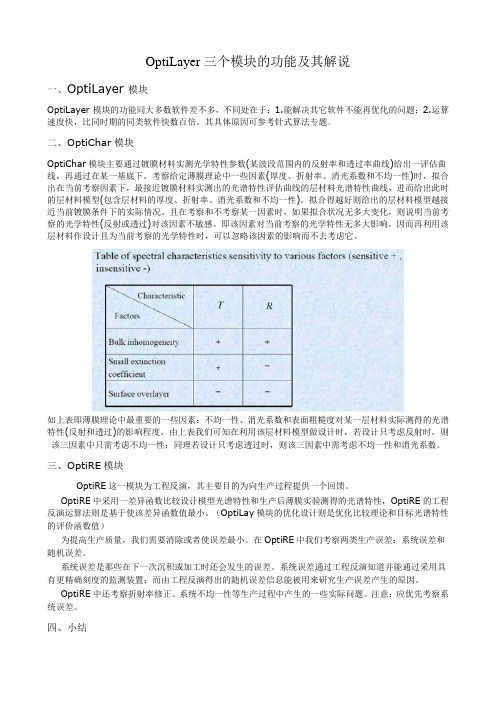
OptiLayer三个模块的功能及其解说一、OptiLayer 模块OptiLayer 模块的功能同大多数软件差不多,不同处在于:1.能解决其它软件不能再优化的问题;2.运算速度快,比同时期的同类软件快数百倍。
其具体原因可参考针式算法专题。
二、OptiChar模块OptiChar模块主要通过镀膜材料实测光学特性参数(某波段范围内的反射率和透过率曲线)给出一评估曲线,再通过在某一基底下,考察给定薄膜理论中一些因素(厚度、折射率、消光系数和不均一性)时,拟合出在当前考察因素下,最接近镀膜材料实测出的光谱特性评估曲线的层材料光谱特性曲线,进而给出此时的层材料模型(包含层材料的厚度、折射率、消光系数和不均一性)。
拟合得越好则给出的层材料模型越接近当前镀膜条件下的实际情况。
且在考察和不考察某一因素时,如果拟合状况无多大变化,则说明当前考察的光学特性(反射或透过)对该因素不敏感。
即该因素对当前考察的光学特性无多大影响。
因而再利用该层材料作设计且为当前考察的光学特性时,可以忽略该因素的影响而不去考虑它。
如上表即薄膜理论中最重要的一些因素:不均一性、消光系数和表面粗糙度对某一层材料实际测得的光谱特性(反射和透过)的影响程度。
由上表我们可知在利用该层材料模型做设计时,若设计只考虑反射时,则该三因素中只需考虑不均一性;同理若设计只考虑透过时,则该三因素中需考虑不均一性和消光系数。
三、OptiRE模块OptiRE这一模块为工程反演,其主要目的为向生产过程提供一个回馈。
OptiRE中采用一差异函数比较设计模型光谱特性和生产后薄膜实验测得的光谱特性, OptiRE的工程反演运算法则是基于使该差异函数值最小。
(OptiLay模块的优化设计则是优化比较理论和目标光谱特性的评价函数值)为提高生产质量,我们需要消除或者使误差最小。
在OptiRE中我们考察两类生产误差:系统误差和随机误差。
系统误差是那些在下一次沉积或加工时还会发生的误差。
德国爱思强:用于LED制造的MOCVD技术

MOCVD = Metalorganic Chemical Vapor Deposition
08.10.2010 P4
Compound Semiconductor Systems
Leading edge design to manufacturing Flexible wafer configuration from 2”-300 mm Configurable common platform Integrated automated solutions Customized turn-key solutions Proven industry standard & market leader
42x2“ Area: 100% ref. Yield: 100% ref.
11x4“ Area: 101% Yield: 110%*
6x6“ Area: 125% Yield: 140%*
08.10.2010 P 13
* 2 mm edge exclusion
Same MOCVD reactor allows up to 40% increase in productivity
002micronmicronsubstratewafernormallymadefromgalliumarsenidegaasindiumphosphideinp350650micron26inches11000mm外延片的横截面外延层3a族和5a族元素厚度
MOCVD Technology for LED
n-Contact
4
Evaporation
1
+ lift-off
5
p-Contact Litho
PCL3维点云的模板匹配
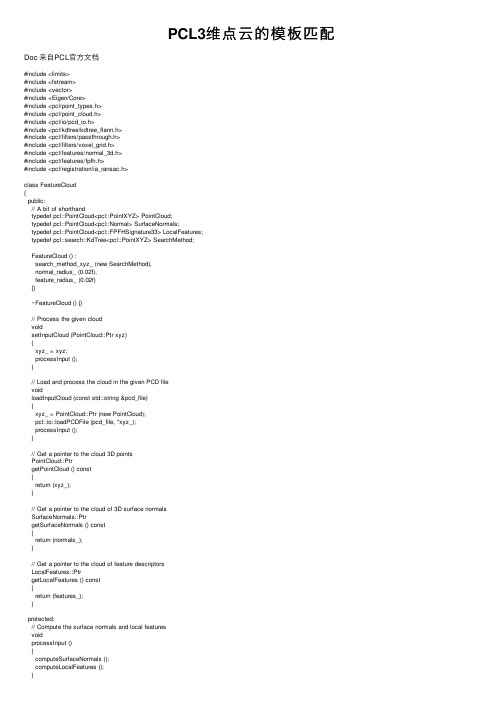
PCL3维点云的模板匹配Doc 来⾃PCL官⽅⽂档#include <limits>#include <fstream>#include <vector>#include <Eigen/Core>#include <pcl/point_types.h>#include <pcl/point_cloud.h>#include <pcl/io/pcd_io.h>#include <pcl/kdtree/kdtree_flann.h>#include <pcl/filters/passthrough.h>#include <pcl/filters/voxel_grid.h>#include <pcl/features/normal_3d.h>#include <pcl/features/fpfh.h>#include <pcl/registration/ia_ransac.h>class FeatureCloud{public:// A bit of shorthandtypedef pcl::PointCloud<pcl::PointXYZ> PointCloud;typedef pcl::PointCloud<pcl::Normal> SurfaceNormals;typedef pcl::PointCloud<pcl::FPFHSignature33> LocalFeatures;typedef pcl::search::KdTree<pcl::PointXYZ> SearchMethod;FeatureCloud () :search_method_xyz_ (new SearchMethod),normal_radius_ (0.02f),feature_radius_ (0.02f){}~FeatureCloud () {}// Process the given cloudvoidsetInputCloud (PointCloud::Ptr xyz){xyz_ = xyz;processInput ();}// Load and process the cloud in the given PCD filevoidloadInputCloud (const std::string &pcd_file){xyz_ = PointCloud::Ptr (new PointCloud);pcl::io::loadPCDFile (pcd_file, *xyz_);processInput ();}// Get a pointer to the cloud 3D pointsPointCloud::PtrgetPointCloud () const{return (xyz_);}// Get a pointer to the cloud of 3D surface normalsSurfaceNormals::PtrgetSurfaceNormals () const{return (normals_);}// Get a pointer to the cloud of feature descriptorsLocalFeatures::PtrgetLocalFeatures () const{return (features_);}protected:// Compute the surface normals and local featuresvoidprocessInput (){computeSurfaceNormals ();computeLocalFeatures ();}// Compute the surface normalsvoidcomputeSurfaceNormals (){normals_ = SurfaceNormals::Ptr (new SurfaceNormals);pcl::NormalEstimation<pcl::PointXYZ, pcl::Normal> norm_est;norm_est.setInputCloud (xyz_);norm_est.setSearchMethod (search_method_xyz_);norm_est.setRadiusSearch (normal_radius_);norm_pute (*normals_);}// Compute the local feature descriptorsvoidcomputeLocalFeatures (){features_ = LocalFeatures::Ptr (new LocalFeatures);pcl::FPFHEstimation<pcl::PointXYZ, pcl::Normal, pcl::FPFHSignature33> fpfh_est;fpfh_est.setInputCloud (xyz_);fpfh_est.setInputNormals (normals_);fpfh_est.setSearchMethod (search_method_xyz_);fpfh_est.setRadiusSearch (feature_radius_);fpfh_pute (*features_);}private:// Point cloud dataPointCloud::Ptr xyz_;SurfaceNormals::Ptr normals_;LocalFeatures::Ptr features_;SearchMethod::Ptr search_method_xyz_;// Parametersfloat normal_radius_;float feature_radius_;};class TemplateAlignment{public:// A struct for storing alignment resultsstruct Result{float fitness_score;Eigen::Matrix4f final_transformation;EIGEN_MAKE_ALIGNED_OPERATOR_NEW};TemplateAlignment () :min_sample_distance_ (0.05f),max_correspondence_distance_ (0.01f*0.01f),nr_iterations_ (500){// Initialize the parameters in the Sample Consensus Initial Alignment (SAC-IA) algorithm sac_ia_.setMinSampleDistance (min_sample_distance_);sac_ia_.setMaxCorrespondenceDistance (max_correspondence_distance_);sac_ia_.setMaximumIterations (nr_iterations_);}~TemplateAlignment () {}// Set the given cloud as the target to which the templates will be alignedvoidsetTargetCloud (FeatureCloud &target_cloud){target_ = target_cloud;sac_ia_.setInputTarget (target_cloud.getPointCloud ());sac_ia_.setTargetFeatures (target_cloud.getLocalFeatures ());}// Add the given cloud to the list of template cloudsvoidaddTemplateCloud (FeatureCloud &template_cloud){templates_.push_back (template_cloud);}// Align the given template cloud to the target specified by setTargetCloud ()voidalign (FeatureCloud &template_cloud, TemplateAlignment::Result &result)sac_ia_.setInputCloud (template_cloud.getPointCloud ());sac_ia_.setSourceFeatures (template_cloud.getLocalFeatures ());pcl::PointCloud<pcl::PointXYZ> registration_output;sac_ia_.align (registration_output);result.fitness_score = (float) sac_ia_.getFitnessScore (max_correspondence_distance_);result.final_transformation = sac_ia_.getFinalTransformation ();}// Align all of template clouds set by addTemplateCloud to the target specified by setTargetCloud ()voidalignAll (std::vector<TemplateAlignment::Result, Eigen::aligned_allocator<Result> > &results){results.resize (templates_.size ());for (size_t i = 0; i < templates_.size (); ++i){align (templates_[i], results[i]);}}// Align all of template clouds to the target cloud to find the one with best alignment scoreintfindBestAlignment (TemplateAlignment::Result &result){// Align all of the templates to the target cloudstd::vector<Result, Eigen::aligned_allocator<Result> > results;alignAll (results);// Find the template with the best (lowest) fitness scorefloat lowest_score = std::numeric_limits<float>::infinity ();int best_template = 0;for (size_t i = 0; i < results.size (); ++i){const Result &r = results[i];if (r.fitness_score < lowest_score){lowest_score = r.fitness_score;best_template = (int) i;}}// Output the best alignmentresult = results[best_template];return (best_template);}private:// A list of template clouds and the target to which they will be alignedstd::vector<FeatureCloud> templates_;FeatureCloud target_;// The Sample Consensus Initial Alignment (SAC-IA) registration routine and its parameterspcl::SampleConsensusInitialAlignment<pcl::PointXYZ, pcl::PointXYZ, pcl::FPFHSignature33> sac_ia_; float min_sample_distance_;float max_correspondence_distance_;int nr_iterations_;};// Align a collection of object templates to a sample point cloudintmain (int argc, char **argv){if (argc < 3){printf ("No target PCD file given!\n");return (-1);}// Load the object templates specified in the object_templates.txt filestd::vector<FeatureCloud> object_templates;std::ifstream input_stream (argv[1]);object_templates.resize (0);std::string pcd_filename;while (input_stream.good ()){std::getline (input_stream, pcd_filename);if (pcd_filename.empty () || pcd_filename.at (0) == '#') // Skip blank lines or commentscontinue;FeatureCloud template_cloud;template_cloud.loadInputCloud (pcd_filename);object_templates.push_back (template_cloud);input_stream.close ();// Load the target cloud PCD filepcl::PointCloud<pcl::PointXYZ>::Ptr cloud (new pcl::PointCloud<pcl::PointXYZ>);pcl::io::loadPCDFile (argv[2], *cloud);// Preprocess the cloud by...// ...removing distant pointsconst float depth_limit = 1.0;pcl::PassThrough<pcl::PointXYZ> pass;pass.setInputCloud (cloud);pass.setFilterFieldName ("z");pass.setFilterLimits (0, depth_limit);pass.filter (*cloud);// ... and downsampling the point cloudconst float voxel_grid_size = 0.005f;pcl::VoxelGrid<pcl::PointXYZ> vox_grid;vox_grid.setInputCloud (cloud);vox_grid.setLeafSize (voxel_grid_size, voxel_grid_size, voxel_grid_size);//vox_grid.filter (*cloud); // Please see this /Possible-problem-in-new-VoxelGrid-implementation-from-PCL-1-5-0-td5490361.html pcl::PointCloud<pcl::PointXYZ>::Ptr tempCloud (new pcl::PointCloud<pcl::PointXYZ>);vox_grid.filter (*tempCloud);cloud = tempCloud;// Assign to the target FeatureCloudFeatureCloud target_cloud;target_cloud.setInputCloud (cloud);// Set the TemplateAlignment inputsTemplateAlignment template_align;for (size_t i = 0; i < object_templates.size (); ++i){template_align.addTemplateCloud (object_templates[i]);}template_align.setTargetCloud (target_cloud);// Find the best template alignmentTemplateAlignment::Result best_alignment;int best_index = template_align.findBestAlignment (best_alignment);const FeatureCloud &best_template = object_templates[best_index];// Print the alignment fitness score (values less than 0.00002 are good)printf ("Best fitness score: %f\n", best_alignment.fitness_score);// Print the rotation matrix and translation vectorEigen::Matrix3f rotation = best_alignment.final_transformation.block<3,3>(0, 0);Eigen::Vector3f translation = best_alignment.final_transformation.block<3,1>(0, 3);printf ("\n");printf (" | %6.3f %6.3f %6.3f | \n", rotation (0,0), rotation (0,1), rotation (0,2));printf ("R = | %6.3f %6.3f %6.3f | \n", rotation (1,0), rotation (1,1), rotation (1,2));printf (" | %6.3f %6.3f %6.3f | \n", rotation (2,0), rotation (2,1), rotation (2,2));printf ("\n");printf ("t = < %0.3f, %0.3f, %0.3f >\n", translation (0), translation (1), translation (2));// Save the aligned template for visualizationpcl::PointCloud<pcl::PointXYZ> transformed_cloud;pcl::transformPointCloud (*best_template.getPointCloud (), transformed_cloud, best_alignment.final_transformation);pcl::io::savePCDFileBinary ("output.pcd", transformed_cloud);return (0);}结果查看pcl_viewer_debug.exe person.pcd output.pcd。
dropoutlayer参数
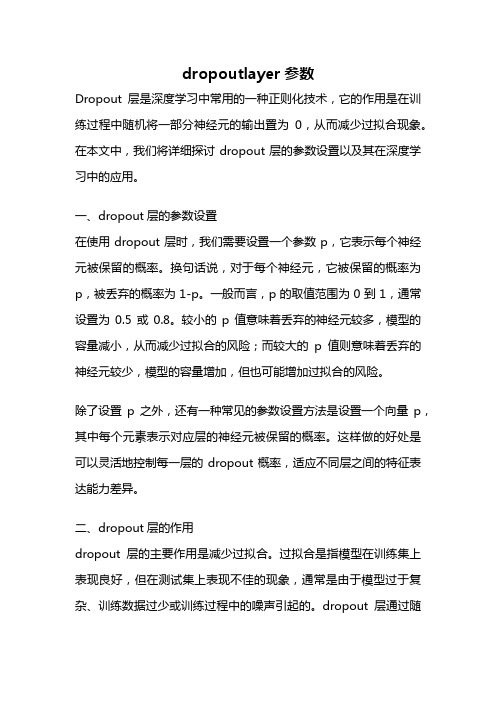
dropoutlayer参数Dropout层是深度学习中常用的一种正则化技术,它的作用是在训练过程中随机将一部分神经元的输出置为0,从而减少过拟合现象。
在本文中,我们将详细探讨dropout层的参数设置以及其在深度学习中的应用。
一、dropout层的参数设置在使用dropout层时,我们需要设置一个参数p,它表示每个神经元被保留的概率。
换句话说,对于每个神经元,它被保留的概率为p,被丢弃的概率为1-p。
一般而言,p的取值范围为0到1,通常设置为0.5或0.8。
较小的p值意味着丢弃的神经元较多,模型的容量减小,从而减少过拟合的风险;而较大的p值则意味着丢弃的神经元较少,模型的容量增加,但也可能增加过拟合的风险。
除了设置p之外,还有一种常见的参数设置方法是设置一个向量p,其中每个元素表示对应层的神经元被保留的概率。
这样做的好处是可以灵活地控制每一层的dropout概率,适应不同层之间的特征表达能力差异。
二、dropout层的作用dropout层的主要作用是减少过拟合。
过拟合是指模型在训练集上表现良好,但在测试集上表现不佳的现象,通常是由于模型过于复杂、训练数据过少或训练过程中的噪声引起的。
dropout层通过随机丢弃神经元的输出,迫使模型不依赖于某些特定的神经元,从而增加模型的泛化能力,减少过拟合的风险。
除了减少过拟合,dropout层还可以起到一种集成学习的效果。
由于dropout层会随机丢弃一部分神经元,每个神经元都有可能被丢弃,因此可以看作是训练了多个不同的模型。
在测试阶段,dropout层被关闭,所有神经元都参与预测,但每个神经元的输出需要乘以保留概率p,以保持与训练阶段的期望输出一致。
这样做可以减少模型的方差,提高模型的稳定性。
三、dropout层在深度学习中的应用dropout层广泛应用于深度学习的各个领域,包括图像分类、目标检测、语音识别等。
在图像分类任务中,dropout层通常被应用在全连接层之间,可以有效减少模型的参数量,提高模型的泛化能力。
FSE+650+4inch+Lift-off+domes+E-Beam+evaporator
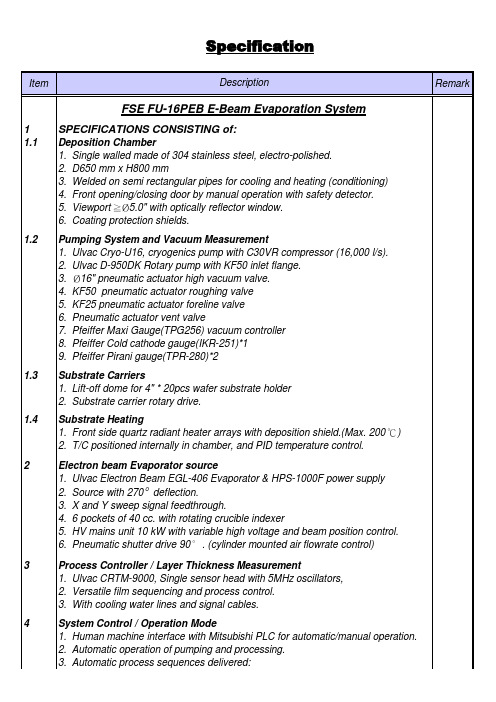
6.3 Compressed Air (For air operated valves) 1. Supply pressure: 5 kg/cm 2 2. Fittings: Φ8mm quick fittings or 3/8" sweagelok
5. Viewport ≧Ø5.0" with optically reflector window.
6. Coating protection shields.
1.2 Pumping System and Vacuum Measurement 1. Ulvac Cryo-U16, cryogenics pump with C30VR compressor (16,000 l/s). 2. Ulvac D-950DK Rotary pump with KF50 inlet flange. 3. Ø16" pneumatic actuator high vacuum valve. 4. KF50 pneumatic actuator roughing valve 5. KF25 pneumatic actuator foreline valve 6. Pneumatic actuator vent valve 7. Pfeiffer Maxi Gauge(TPG256) vacuum controller 8. Pfeiffer Cold cathode gauge(IKR-251)*1 9. Pfeiffer Pirani gauge(TPR-280)*2
Specification
Item
Description
Remark
FSE FU-16PEB E-Beam Evaporation System
- 1、下载文档前请自行甄别文档内容的完整性,平台不提供额外的编辑、内容补充、找答案等附加服务。
- 2、"仅部分预览"的文档,不可在线预览部分如存在完整性等问题,可反馈申请退款(可完整预览的文档不适用该条件!)。
- 3、如文档侵犯您的权益,请联系客服反馈,我们会尽快为您处理(人工客服工作时间:9:00-18:30)。
Single Layer Lift-Off: Image Reversal of Positive Resist, to create a negativesidewall profile for Clean Lift-OffDate: 08/22/2008Revisionist:Paul KimaniRevision #: 1In this process, we use single layer positive resist S1805 to enable a lift-off of 1000 Å of Au on 100 Å of chrome evaporated with e-beam on a patterned wafer.Background on Image Reversal for positive photoresists1With an image reversal technique, the exposed area remains after the process. This is as if you are using a negative resist. Therefore, in designing your mask pattern, you need to create a pattern that is the inverse of the one you desire.In a standard positive photoresist process, if you expose the photoresist as depicted above, the exposed area becomes more soluble in developer and would be washed away if you develop at this point.The addition of a reversal bake in an ammonia environment cross-links the exposed area. The unexposed area remains photoactive. The YES-310 oven uses anhydrous Ammonia (NH3) for the cross-linking process.A flood exposure then makes the previously unexposed resist to now be soluble in developer. After development, the areas exposed in the first step are now retained. An undercut profile will result when over-development is performed. A 30% over-develop is recommended (after the features are formed leave wafer in developer for another ⅓ of the time used to create a good undercut). A poor undercut makes it harder to remove unwanted resist during lift-off.Process in the lab1.Dehydrate a bare silicon wafer at 120 °C for at least a minute.2.Expose the wafer to HMDS vapor for 5 minutes, to promote adhesion.3.Spin S1805 at 3000 rpm for 30 seconds.The resulting resist thicknesses are recorded on the above image (measured using the Nanospec and a refractive index of 1.65 for the resist).4.Expose under MABA6 (12 mJ/cm2 output) for 4.5 s. This exposure energy is atleast 50% higher than a normal exposure would be for patterning if no imagereversal is being undertaken.5.Reverse the image by running the wafer in the YES 310 oven using the standardimage reversal program.6.Flood-expose the wafer under Oriel UV light for 14 minutes. At the 7 minutemark, change the orientation of the wafer by approximately 90° after blowing the surface with nitrogen/air gun. The Oriel UV energy is variable and depends on the age of the lamp. The 14 minutes duration has been found to be adequate under most circumstances.7.Develop the wafer in 1: 6 351 developer: DI water mixture, for 35 seconds.Alternatively, watch how long it takes for the developer to clear the features, and then add approximately 30% more time. This extra duration is necessary for a prominent undercut to form. A good undercut makes for a clean lift-off, withminimum problems in clearing the resist from small features. In this example, during the lift-off soaking after deposition, resist cleared from 2 µm features in less than an hour. Overdevelop also minimizes the need for ashing (in oxygen plasma to clean the features), which may cause the undercut to collapse in thicker resists.8.Deposit 100 Å of chrome as adhesion layer and evaporate 1000 Å of gold on topof the chrome. The metal layer thickness was approximately ¼ the thickness of the resist.9.Lift-off unwanted material by soaking the wafer in 1165 resist removermaintained at 80 °C for approximately 3 hours. An overnight soak in acetonehelps to clean the wafer further.Figure 1: Broad view of features after lift-offFigure 2: 2 µm serpentine features. The lift-off process leaves very little residue, thus providing clean features necessary for further downstream processing.Figure 3: Analysis of features obtained from lift-off using AFMThe images show that the width of the serpentine metal lines are wider than the 2 µm (it is ~ 2.5 µm), while the width of the spaces are less than 2 µm. In the design of the mask, if the goal is to obtain an even pitch of say 4 µm (2 µm spaces and 2 µm lines), it would be necessary to include some bias, i.e. decrease the width of the chrome on the mask by 0.5 µm and increase that of the space to 2.5 µm.The areas of photoresist under the chrome are not exposed during first exposure. They are flood exposed after image reversal. Over-development is applied to increase the width of subsequent features, as well as form the undercut, but this increase will have been counteracted by the bias included in the mask design, (an equivalent decrease in the width of the light absorbing chrome region).Figure 4: Analysis of features obtained from lift-off using Confocal Microscopy1 Adopted from: "image reversal, resists, semiconductor, structuring". Application notes for image reversal resists; Dr. Christian Koch - MicroChemicals GmbH。
